#even the background characters often fail to include women
Explore tagged Tumblr posts
Text
observations from grading hundreds of american college students' discussion posts and essays about film
before i get into this i want to be SO clear that this is not meant to be a "kids these days" thing, but more a commentary on the contemporary media landscape and the impacts of new media on young people's consumption habits. i think that young people's expectations of film are primarily a reflection of how they've been taught to watch and process film.
also, i teach intro, so these are not necessarily film or even humanities majors. many of my students are in computer science, engineering, etc. okay yay let's go <3
most american college students have quite literally Never seen a single movie that was not in english, and are very resistant to reading subtitles.
i've had multiple students comment that non-english language films which require them to read subtitles force them to actually look at the screen, which makes them notice more details in the film. they are not accustomed to actually Watching films, and doing so is novel to them. they're used to just turning things on in the background before doing other tasks/scrolling on their phones.
students frequently comment upon whether or not a film was able to hold their attention, and many consider it a failing of the film itself if not. many students also lose interest when they are confused or uncertain about what is happening in a movie, rather than becoming more invested or intrigued.
some do note that they have short attention spans, and will clearly state that they do not watch or enjoy many movies because of this.
things which students see as inherently boring include black and white films, silent films, non-English-language films, and films more than twenty years old. many students were shocked when they enjoyed a film within any of the aforementioned categories.
a lot of students will see all of the pieces of the puzzle, but struggle to put them together. for example: they will note that a detective character seems to care more about pinning a crime on somebody than they care about actually solving it, that the detective is bad at their job, that the detective brutalizes suspects, but they will not quite reach the conclusion that the film is doing these things intentionally. rather than concluding that the film is criticizing the police, they will be upset that the character is so awful.
one student insisted that mad max: fury road is a deeply misogynistic film because the women were treated as objects and wore skimpy clothes. the fact that the entire plot of the film is about said women asserting their personhood and overthrowing the patriarchal order to establish a more egalitarian and empathetic matriarchy was not relevant to her; what mattered was how they looked, and no amount of explanation could change her mind. i don't really have a clear theory of what was going on here, but i wanted to share it because it feels. poignant. in a way i cannot articulate.
many students see "old" films as inherently worse than contemporary films. they will often say things like, "the movie was really good for something from the fifties."
a lot of people have never heard of alfred hitchcock. i don't rly have a take on this it just stunned me.
and this last one isn't necessarily film-specific, but i do think it's relevant to discussing media literacy and the quality of k-12 + STEM-focused university education: so many students do not know how to format a paper, and do not know how/do not think to look up a style guide or even consult the syllabus or assignment sheet.
students often add additional spaces between paragraphs, and/or use 1.15 pt. spacing rather than double spacing their papers. they'll use calibri or arial rather than times new roman, in 11 pt. font rather than 12. they'll write out their thesis separately from their paragraphs, or not write in paragraphs at all, instead writing something that looks closer to stream-of-consciousness bullet-point notes.
it seems to me that many students somehow make it through high school and into university without ever learning how to write a paper. what really concerns me however is the fact that this information is extremely available to them; in the class syllabus, on their assignment sheet, even if you just google how to write a paper. i'm no expert in education and i don't want to be alarmist, but i do think that there is a concerning lack of curiosity and care in many students, primarily those studying in STEM fields. part of this is just the fact that many of my students are used to writing lab reports and this is a different sort of writing, but the lack of flexibility and ability to engage with other subjects is very sad to me.
plenty of my students are curious and read the syllabus and pay attention to the films and know how to write! but the number of those who struggle to formulate a coherent paragraph, let alone paper, who cannot identify basic themes, indicates to me that young people are seriously suffering from shortened attention spans, the lack of popular non-english language film and television in american culture, and the proliferation of "second-screen" streaming content designed to be "viewed" by audiences who are not paying attention.
i don't have a remedy for this. i don't totally know why i'm typing this all out, except that my tenure as a teaching assistant is coming to an end and i felt an irrepressible urge to reflect upon the experience. idk i suppose i hope this will be interesting to somebody. if you made it this far, thank you and i hope you're well <3
81 notes
·
View notes
Text
SHADOW’S CHARACTER BIO: METAL BREAKERS AU
NAME: Shadow
AGE: ???
SPECIES: Hedgehog like bio-engineered organism.
HEIGHT: 3’3"
WEIGHT: 77 lbs
OCCUPATION:
Currently classified as a failed weapon
PHYSICAL STATUS:
Shadow remains in peak physical condition. Engineered to be the Ultimate Lifeform, his body is resistant to aging, disease, and physical fatigue. His reflexes, speed, and durability remain superior to most Resistance soldiers, although years in stasis and inactivity have dulled his edge. His regenerative abilities, while not limitless, allow for rapid recovery from most injuries.
MENTAL STATUS:
Shadow displays strong signs of emotional volatility and a lack of loyalty toward Resistance leadership. He is highly intelligent and tactical, but deeply insubordinate and often refuses direct orders. While he is useful in the field for now, there is growing concern that his independence and unpredictable behavior could pose a long-term threat to Resistance operations.
COMBAT EFFICIENCY:
Once considered the peak of bio-engineered combat potential, Shadow’s raw power has been eclipsed by newer generations of enhanced fighters and upgraded Resistance soldiers. Despite this, he remains a force to be reckoned with. His Chaos abilities, including short-range teleportation, energy-based attacks, and temporary time dilation, give him an advantage few others possess. He is still capable of outmaneuvering or overpowering most standard opponents, though he struggles against high-tier Resistance operatives in direct confrontation. His fighting style is aggressive, fluid, and highly adaptive.
RELATIONSHIPS:
Shadow has developed a tense and competitive relationship with Dr. Miles "Tails" Prower, who views him as dangerous and expendable. Shadow typically retreats or disengages when Tails becomes hostile, though it is unclear whether this is due to fear or restraint. He remains distant from most members of the Resistance but shows more respect and restraint around women, particularly Rouge, whom he saved during the team's retreat from Prison Island. Shadow has also taken a curious interest in Zero, a Resistance soldier, and appears to be forming a reluctant mentorship with him, offering occasional advice and guidance during training and missions.
BACKGROUND:
Shadow the Hedgehog was created over sixty years ago aboard the Space Colony ARK as the final result of Project Shadow, a classified government operation initiated under the false premise of achieving immortality. The real objective was to develop biological weapons of unprecedented power. Professor Gerald Robotnik, considered the most brilliant scientific mind of his generation, initially refused to take part in the project due to his ethical concerns and suspicions about the military’s intentions. However, his stance changed when he realized the research could be redirected to cure his granddaughter Maria’s terminal illness, Neuro-Immune Deficiency Syndrome. Isolated from Earth, Gerald accepted the position and began conducting advanced experiments aboard the ARK. His early efforts, involving Chaos Emerald energy, led to the creation of the Biolizard, the prototype Ultimate Life Form. Although the Biolizard demonstrated regenerative abilities and Chaos-based functions, it grew unstable and uncontrollable, lacking intelligence and requiring a life support system to survive.
Unsatisfied with the results, Gerald entered into a dangerous agreement with Black Doom, the alien leader of the Black Arms, in exchange for assistance and genetic material. With Black Doom’s DNA, Gerald engineered a second prototype, this time designing it to resemble a hedgehog and embody traits of compassion and strength. Influenced by Maria’s belief that even shadows can guide one toward the light, Gerald chose to create Shadow not as a weapon but as a symbol of hope and protection. Shadow developed a close bond with Maria and became deeply curious about Earth, though he often wondered about his own origins and purpose.
Their time together ended when the military organization G.U.N. learned of the project’s true nature and launched a secret operation to shut it down. Under the pretense of a biohazard outbreak, G.U.N. stormed the ARK, killing researchers, detaining Gerald, and fatally shooting Maria as she helped Shadow escape. With her last breath, Maria sent Shadow to Earth in an escape pod. Gerald, driven by grief and rage, was imprisoned on Prison Island where he secretly reprogrammed Shadow and devised a plan to crash the ARK into Earth as revenge for Maria’s death. He was executed before the plan could unfold, and Shadow was placed in suspended animation in a secure G.U.N. facility.
Years later, Tails came into possession of Gerald’s journal, retrieved by Rouge during an expedition through one of Robotnik’s abandoned bases. Intrigued by the scientific breakthroughs detailed within, Tails studied the contents extensively. The journal inspired new advancements, including his development of chaos drive technology and enhancements to his own body using concepts derived from Project Shadow. Upon discovering references to a living Ultimate Life Form held in stasis within an abandoned G.U.N. prison, Tails saw an opportunity. Believing he could awaken Shadow and use him as a weapon against the Metal Empire, he formed a team with Rouge and Knuckles and launched an infiltration mission on Prison Island.
Armed with a single Chaos Emerald locked in a suppression cage, the team fought their way through deteriorated G.U.N. defense units to reach Shadow’s chamber. Once inside, Tails used the Emerald to activate Gerald’s terminal and awakened Shadow from stasis. Upon revival, Shadow agreed to join the mission against the Metal Emperor on the condition that he be given the Emerald. Tails, suspecting Shadow’s intent, refused and instead attached a device to Shadow’s arm capable of drawing ambient Chaos Energy from the world. Shadow, dissatisfied, attempted to seize the Emerald, prompting Tails to strike him. In response, Shadow teleported behind Tails using Chaos Control and launched a counterattack, but Tails had already applied the same technology to himself. He dodged the assault and retaliated with a crushing blow that knocked Shadow into the ground. Determining that Shadow was unpredictable and a liability, Tails called off the mission and declared Shadow useless to the resistance.
However, as the group exited the facility, they were ambushed by a squad of Metal Spawn. Despite a fierce battle, Rouge was overwhelmed and called for help. Tails, focused on securing the Emerald, refused to assist. Just as defeat seemed inevitable, Shadow returned unexpectedly and rescued Rouge, helping repel the enemy forces. His actions earned him a reluctant place in the resistance, with Rouge personally vouching for him. Tails, still distrusting, opposed Shadow’s involvement and issued a warning that if Shadow came near the Emerald again, he would not hesitate to kill him.
#metal breakers au#sonic the hedgehog#sth#sonic fandom#miles tails prower#tails the fox#tails#miles prower#sth au#sonic au#shadow the ultimate lifeform#shadow the hedgehog#rouge the bat
20 notes
·
View notes
Text
CRIMINAL CASE OCS, PT 1
This has been a WIP for quite some time, but I have finally finished the OC sheet for my Mysteries of the Past player character, Ethel Evanoff! (Note: she's not the same player character as the rest of the games). Tagging @chelleinyy as asked! Information about Ethel is found under the cut. Spoilers for Mysteries of the Past, and TW for mentions of mild sexism, physical and mental illnesses, and war.
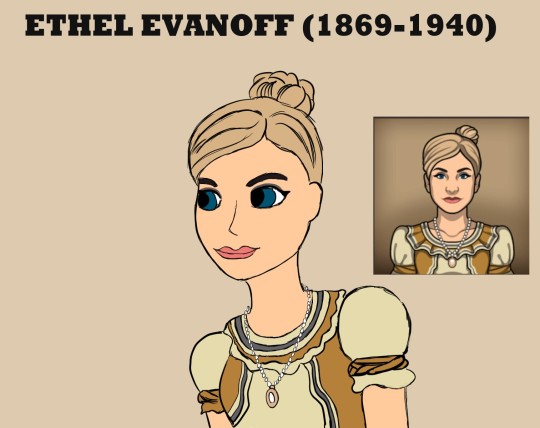
Born in the United States, parents were immigrants from the Russian Empire
Always wanted to be a police officer/detective, but no one in her local departments wanted to hire a woman. However, she’d heard of Concordia’s progressiveness and willingness to give women opportunities other cities were not, and so she moved to Concordia and worked with the Concordian Police Department.
Over the years, grew irritated with corruption and laziness in the police department, and therefore showed great interest in the Flying Squad when it was formed, and was hired by Arthur at age 28 in December of 1897.
Always tried to be a mediator between suspects and the police, not very prone to anger--the “good cop,” if you will. However, this kindness while still being professional led to her growing quite fond of many suspects and liking them as people. This led to her being more affected than other detectives/officers when they died.
The events of Sinner’s End, Coyote Gorge, and Crimson Banks very negatively affected her. Seeing the Flying Squad’s complete inability to catch the Scarlet Slayer in Sinner’s End until she’d already killed countless young women, being unable to protect Vinnie after promising him protection, and being unable to prevent innocent civilians, including children, from being often fatally dragged into the gang war caused immense guilt, and her mental health began to suffer.
After Capital Peak, she was depressed and traumatized, having lost a friend she cared greatly about and not being able to save enough people who counted on her during her career. Her depression worsened when her parents both died in the early 1900s.
After her parents died and not feeling capable of working in a job where she was never able to prevent death, she retired from the Flying Squad, although she remained friends with her former colleagues.
Instead, she began to train to be a nurse, hoping that while obviously she couldn't save everyone, she would atone for all of the lives she couldn't save during her career by being able to actively work to help and save lives, hoping saving lives would assuage her persistent guilt.
Being a nurse didn't "cure" her depression by any means, but she found more purpose as a nurse than she did as a detective. She always smiled when a patient recovered from an operation or illness and was able to return home, and patients loved her for her ability to listen and her care for each individual in the hospital she worked. Additionally, she was able to befriend several coworkers.
Of course, when doctors failed to save patients, she felt the familiar sting of grief and guilt, even if she had nothing to do with the patient's conditions and any operation that failed to save their lives. She continued in her work, working herself to the bone to do her job as best as possible.
When World War I broke out, she was asked to serve as a nurse, considering her background in being more familiar with blood and violence than other nurses, and her high quality of work. While reluctant, she agreed, influenced and swept up in all of the pro-war, guilt-tripping propaganda constantly bombarding her (and everyone else in the nation), and at least hoping that she could still continue to save lives on the warfront.
While serving as a nurse, she was bit by a rabid racoon that wandered into her encampment. It was able to be put down before biting anyone else, and she was able to get a rabies vaccine before she contracted the disease, saving her life.
The war greatly disturbed her, making her PTSD and depression worse. Although she was indeed able to comfort and help many people in the war, the horrific injuries she saw on young men in the war never left her and joined her nightmares, along with images of particularly bad crime scenes she’d seen in her life.
However, what worsened her mental health most of all is the fact that all of her brothers--her only siblings-- served in and died in the war.
During the war, she fell in love with one of her fellow nurses. They courted, and he was able to bring some happiness, and companionship to her. They wrote letters while stationed in different places, which was a small comfort through the death of her brothers.
He proposed near the end of the war. However, before they could marry, he died in late 1918 of the Spanish flu, leaving her even more grief-stricken and heartbroken.
After the war, she spent time in urbanizing cities, appreciating the hustle and bustle/noise of industrialization over the quietness of nature, where there was little to distract from her troubled thoughts. She frequently painted as a way to cope with/distract from the death and blood she had seen for years, and frequently painted her would-be husband and family.
When war broke out again in 1939, she was in failing health and could not be a nurse again, and struggled to express herself in her art due to her poor health. Hearing of the violence happening again, on an even larger scale, throughout the world greatly distressed her and brought back disturbing memories of the death she had seen in her careers and personal life.
Kept letter correspondence with friends and colleagues throughout her life, but died alone in 1940 at the age of 71.
#criminal case mysteries of the past#criminal case#criminal case game#criminal case facebook#mysteries of the past#oc#ethel evanoff#cc motp
30 notes
·
View notes
Text
Christopher Nolan’s highly-anticipated movie “Oppenheimer,” set for release July 21, 2023, depicts J. Robert Oppenheimer and his role in the development of the atomic bomb. But while the Manhattan Project wouldn’t have been possible without the work of many accomplished female scientists, the only women seen in the movie’s trailer are either hanging laundry, crying or cheering the men on.The only women featured in the official trailer for Christopher Nolan’s ‘Oppenheimer’ are crying, hanging laundry or supporting the men.
As a physics professor who studies ways to support women in STEM – science, technology, engineering and math – fields and a film studies professor who worked as a screenwriter in Hollywood, we believe the trailer’s depiction of women reinforces stereotypes about who can succeed in science. It also represents a larger trend of women’s contributions in science going unrecognized in modern media.
Lise Meitner: A pioneering role model in physics
The Manhattan Project would not have been possible without the work of physicist Lise Meitner, who discovered nuclear fission. Meitner used Einstein’s E=MC² to calculate how much energy would be released by splitting uranium atoms, and it was that development that would prompt Einstein to sign a letter urging President Franklin Roosevelt to begin the United States’ atomic research program.
Einstein called Meitner the “Madame Curie of Germany” and was one of a pantheon of physicists, from Max Planck to Niels Bohr, who nominated Meitner for a Nobel Prize 48 times during her lifetime.
Meitner never won. Instead, the prize for fission went to Otto Hahn, her male lab partner of 30 years in Berlin. Hahn received the news of his nomination under house arrest in England, where he and other German scientists were being held to determine how far the Third Reich had advanced with its atomic program.
Of Jewish descent, Meitner had been forced to flee the Nazis in 1938 and refused to use this scientific discovery to develop a bomb. Rather, she spent the rest of her life working to promote nuclear disarmament and advocating for the responsible use of nuclear energy.
Meitner was not the only woman who made a significant contribution during this time. But the lack of physics role models like Meitner in popular media leads to real-life consequences. Meitner doesn’t appear as a character in the film, as she was not part of the Manhattan Project, but we hope the script alludes to her groundbreaking work.
A lack of representation
Only around 20% of the undergraduate majors and Ph.D. students in physics are women. The societal stereotypes and biases, expectation of brilliance, lack of role models and chilly culture of physics discourage many talented students from historically marginalized backgrounds, like women, from pursuing physics and related disciplines.
Societal stereotypes and biases influence students even before they enter the classroom. One common stereotype is the idea that genius and brilliance are important factors to succeed in physics. However, genius is often associated with boys, and girls from a young age tend to shy away from fields associated with innate brilliance.
Studies have found that by the age of 6, girls are less likely than boys to believe they are “really, really smart.” As these students get older, often the norms in science classes and curricula tend not to represent the interests and values of girls. All of these stereotypes and factors can influence women’s perception of their ability to do physics.
Research shows that at the end of a yearlong college physics course sequence, women with an “A” have the same physics self-efficacy as men with a “C”. A person’s physics self-efficacy is their belief about how good they are at solving physics problems – and one’s self-efficacy can shape their career trajectory.
Women drop out of college science and engineering majors with significantly higher grade-point averages than men who drop out. In some cases, women who drop out have the same GPA as men who complete those majors. Compared to men, women in physics courses feel significantly less recognized for their accomplishments. Recognition from others as a person who can excel in physics is the strongest predictor of a student’s physics identity, or whether they see themselves as someone who can excel in physics.
More frequent media recognition of female scientists, such as Meitner, could vicariously influence young women, who may see them as role models. This recognition alone can boost young women’s physics self-efficacy and identity.
When Meitner started her career at the beginning of the 20th century, male physicists made excuses about why women had no place in a lab – their long hair might catch fire on Bunsen burners, for instance. We like to believe we have made progress in the past century, but the underrepresentation of women in physics is still concerning.
Diversity as an asset to science
If diverse groups of scientists are involved in brainstorming challenging problems, not only can they devise better, future-oriented solutions, but those solutions will also benefit a wider range of people.
Individuals’ lived experiences affect their perspectives – for example, over two centuries ago, mathematician Ada Lovelace imagined applications far beyond what the original inventors of the computer intended. Similarly, women today are more likely to focus on applications of quantum computers that will benefit their communities. Additionally, physicists from Global South countries are more likely to develop improved stoves, solar cells, water purification systems or solar-powered lamps. The perspectives that diverse groups bring to science problems can lead to new innovations.
Our intention is not to disparage the “Oppenheimer” movie, but to point out that by not centering media attention on diverse voices – including those of women in physics like Meitner – filmmakers perpetuate the status quo and stereotypes about who belongs in physics. Additionally, young women continue to be deprived of exposure to role models who could inspire their academic and professional journeys'
75 notes
·
View notes
Text
fyi. you do not want to follow me yet if you care even a little about worm spoilers because i am just going around Posting Shit About The Whole Book 24/7. and i would actually recommend caring about worm spoilers because it's fun to be surprised by some of the shit that's gonna happen. but anyway
i will also thoroughly defend most of the happenstances of Boys Thinking That Talking About Their Feelings Is Girly Shit. taylor commentating "woah bitch is strong....not as strong as a man would be though" is authorial misogyny and all, but for the most part, worm is...really refreshingly good about gender. for all that worm is infuriatingly lesbophobic, i would kill for every book written by a dude to contain worm's level of important female characters written w/ interiority, nuance, and care. yeah, the narrator still can't shut the fuck up about the breast size of random women, but also the women in this book are some of the most viscerally human characters i have ever seen in anything ever. (and i'd ballpark that about 65% of taylor's bad opinions about gender are bad on purpose and intended to be read as a direct result of her trauma.) i presume you're talking about brian specifically here when you bring up unhealthy attitudes towards gender, though, because he's the poster child for that shit. to which i must inform you that this is actually an intentional and really well-written character detail, it's just that wildbow's dumb fucking ass just Didn't Include the singular piece of background information about brian which ties the characterization together in the story. he only revealed it via WoG:
brian lied about his trigger event. his ass was fucking lying. he was out there telling lies. not about beating up his abuser for aisha, but about being cold and emotionless during it. about not knowing who the man was.


this is what i call the Brian DLC Patch. i.e the bonus information that should've been in the story that's critical for understanding his character. i'm just gonna lazily copy-paste my previous explanation of it:


so yeah brian is misogynist and thinks feelings are for girls, but it's an intentionally-written maladaptive coping mechanism stemming from his desperate desire to remain strong enough to care for his loved ones despite how weak his trauma makes him feel using the only tools he has. brian laborn my boy :( i love him you should let him into your heart and home
wrt this from you in the other thread:
hmm, that’s fair. I’m crushingly aware of how unreliable Taylor is as a narrator, in terms of how she sees herself and how she understands other people. See: clockblocker being nice to her during the echidna fight and her immediately thinking “does he have an angle or is he fucked in the head” But I have been assuming that wildbow generally agrees with her attitude towards the world: mistrustful of authority, optimistic about people, generally opposed to murder as much as it can be avoided. Something to keep in mind going forward!
worm is excellent at understanding and depicting the ways in which taylor's trauma impacts her worldview! nothing about her philosophies is detached from the way she sees herself & understands other people. her mistrust of authority is deeply informed by the way systems of authority have failed her in the past--she can no longer trust anyone else to do good with the authority they have, and thus compulsively struggles to take control herself, because she's the only person she knows the full intent of. i don't want to say she's the only person she can trust to do the right thing, because i think she's very aware that she often Doesn't do the right thing, but the fact that she knows her own intents & consistently aspires to do what she thinks is the right thing means that she would always rather see herself in power than a random authority figure she's paranoid about. it's why she speedruns becoming the new leader of the undersiders & is so effective at building up her territory.
as for the optimism, she desperately wants to believe that people are capable of working together, and is ruthless in her fight for a future where that's possible, but is still deeply pessimistic about society's general ability to Do The Right Thing. it's a direct result of how society failed her when she was being bullied, and it's the exact reason why she buys into some of alexandria's rhetoric--of course she believes that people need to be forced or tricked into working together & treating each other fairly! society never helped her, and in her mind, it never would without being given a stick & carrot!
the closest she ever gets to being a wildbow mouthpiece is when she's expressing bigoted sentiment wildbow regards as a normal default anyone would believe, e.g her hatred of addicts. but she's a nuanced and genuinely incredibly written character outside of that--if you want to look for wildbow's general philosophies, what the traumatized unreliable narrator teenager believes isn't the part to be taking as his PoV.
as for the issue w/ rachel's gender writing, it just boils down to:
the garden-variety butchphobia of "butch" being used as an insult for her
the authorial uncreativity in her adhering to gender norms like wearing skirts despite their impracticality and her disregard for social constructs (which gender is, but wildbow doesn't realize that)
and alec's got a similar issue going on where it's made explicitly clear that other characters in-universe see him as pretty, effeminate, etc--he's literally homophobically mocked for it during a chapter you're not at yet--but wildbow can't conceptualize the impact that this should have on his relationship to gender. he's ostensibly a bisexual gender non-conforming boy, but still effectively written as a straight and gender-conforming boy, because wildbow can't grasp the way either of those details would actually impact his personal identity. it's only ever relevant when wildbow is calling his sexuality "hedonist" in a WoG or having someone make fun of him for looking like a princess, the rest of the time he just...forgets about it. sucks and tragic because i would love if that little guy was bi and gnc for real.
The way gender is performed in worm is soooo weird. Most of the time, wildbow is pretty good about having people act like people, but sometime people act like they’re in Sex and the City.
There’s this exchange in arc 4 or 5 ish, where Taylor is having lunch with the undersiders sans Rachel, and they get huge greasy burgers. Lisa says to Taylor “ugh I bet you never gain any weight!” “I have to work to put it on. If it makes you feel better, this will be terrible for my skin.” “It does make me feel better!” Teehee
Literally what ??? One of my friends said that she and her friends used to do the whole “compliment/deny compliment & compliment you back” routine in middle school, so I guess real people do this sometimes. It feels straight out of a sitcom, though, and it’s such a weird tonal shift.
#worm spoilers#i love when im like. yippee pact time today! and then someone new pulls up to wormblr book club and i have to write one million paragraphs#to them about it#This Keeps Happening To Me
181 notes
·
View notes
Note
Okay so I've been thinking about Tolkien... and I'm not 100% sure how to express my Thoughts but I wanted to dump them on you because I feel like even if I communicate it awkwardly you might understand what I'm trying to say and help refine what I'm saying.
So there are various criticisms of Tolkien wrt his ratio of male to female characters and how he's just not progressive enough, but I feel like a lot of people who use this to insult Tolkien and claim that he was a Bad Person and thus nothing he did was good (or if it was good, it was only accidentally so) don't even realize the much-more-relevant-to-his-era statement he was making about class!
LOTR is the best example of this, because literally all of the Company is royalty or akin to royalty or high class except for Sam. And while each one of them plays an important role in the story, the inarguably Highest Class character (Aragorn) in the most important part of the story is nothing but a distraction, and it's the inarguably Lowest Class character (Sam) who emerges as the most important part of the puzzle, the Real Hero. They are all heroes - Frodo is no less of a hero because he fails in his task, Boromir is no less of a hero because he temporarily falls under the thralldom of the ring, Aragorn is no less of a hero just because in the end he's not much more than a distraction so the Real Heroes can do their thing - but it's Sam, the lowest class one of them all, who is THE hero of the story. And while there are important discussions to be had and to tell in various stories that do include race and gender, I feel like it's disingenuous to ignore the important discussion Tolkien was having about class when talking about important discussions to be had.
And frankly, class is extremely important, and the fact that it's often overlooked in these conversations is very frustrating. To give the most extreme example of this: A black, female, lgbtq, Hollywood celebrity is going to be much less disadvantaged in life than a straight white man who lives on the streets and depends on free food pantries, soup kitchens, and charity to survive. And to say that the straight white man is privileged compared to her is stripping all of the complexity related to class out of that comparison. So I think that Tolkien's statements about class are extremely important conversation points, but which... largely get ignored just because that is the conversation that he was having (which I feel is much more relevant to his era) than conversations that people insist we should be having about him/his work.
And idk... maybe I'm just tired of people calling Tolkien a bad person when he clearly wasn't. He was at worst a product of his times, and even then while he didn't write a ton of stories about women it's clear that he respected women through the stories he told about them. And his infamous replies when Germany asked if he was Aryan proves something similar to his opinions on racism and antisemitism. And since he intentionally was writing a legendarium for his own country, to say that he was racist for essentially saying "the poc are the ones who live far away from where the main story is taking place" and thus were far away from the elves and the gods and things that were Good and so unfortunately were easily manipulated down a dark path by Evil is... well, it's disingenuous. Especially when you consider the important conversation topic he was addressing and was trying to talk about.
I do get what you mean! And I have so many thoughts on this, but I don’t want to share them lol
You see, there is a lot to be said about Tolkien’s social views - both in praise and in condemnation. But critical literary analysis of 20th century literature is an actual academic field, and there’s a reason for that. You need a lot of knowledge and a lot of hard work to be able to accurately, fairly assess a single work - let alone an author’s entire corpus. I, a random person on the internet without that background, am simply not qualified to make that kind of analysis.
Can I have opinions? Sure! I’ve had them since I first encountered Tolkien, and I’ve been refining them ever since! But these are personal and I don’t want the responsibility of holding up my ideas as Good Takes, because I’m very aware of my limitations. For things like “Hey do you have an opinion on this obscure character?” I’m thrilled to share all my opinions, but for things that are (rightfully!) considered such serious subjects because they affect real life people, I feel like the only thing I can do is take a step back and admit I probably don’t have particularly good answers.
Can you probably guess that I think Tolkien does some things right and some things wrong, just by reading through this blog? Absolutely, but that’s the nature of interacting with any kind of art. But to go out of my way to present A Unified Opinion is more than I am prepared to do.
I do think you make a very valid point, and I agree with much, though not necessarily all, of it, but to quote LotR, this would need “a week’s answer, or none.” As I’m not comfortable with sharing a week’s answer for the reasons above, I’ll just have to go with none, even though I very much get where you’re coming from with this!
25 notes
·
View notes
Text
The Creative Directors Behind Fate: The Winx Saga Must Not Be K-Pop Fans
Also, they have a pretty wrong idea of the role fashion should play in a show.
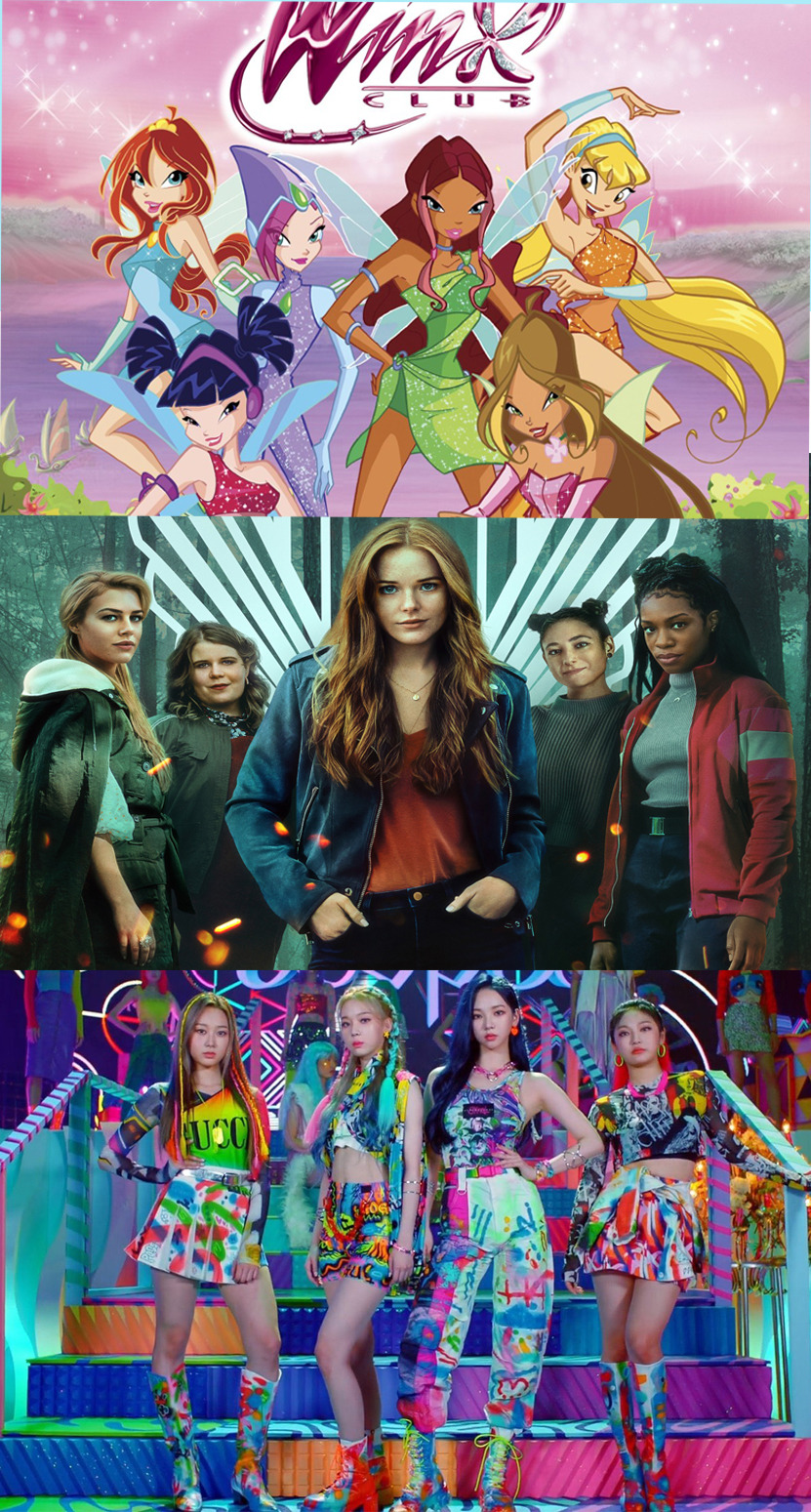
There are a few words that will stand out across most reviews of Netflix's Fate: The Winx Saga - drab, boring, flop, flat, unimaginative. Critics and audiences consensus is that the show is not only a mediocre-at-best story, but also an atrocious (and ultimately confusing) choice of adaptation of the color pop and fairy magic cartoon it’s based on, 2004 italian cartoon Winx Club.
Fate has plenty of it's own issues - white washing and erasing characters, cringey dialogue, outdated melodrama, etc. But where it truly, unequivocally fails is as an adaptation. Fate misses everything that was magical and lovable about the original series, in all levels, from bizarre writing choices, - such as never actually developing any sense of friendship between the characters, who are based on a cartoon about…..a group…….of friends -, but it's especially and immediately felt in the art direction and costume design.
Winx Club is set on a fantastical world, Magix, where each of our main characters hail from a different planet, à la Sailor Moon. Alfea, the fairy school they attend, is the most common background: a pastel colored, futuristic high tech-meets-fantasy, art nouveau inspired castle. Alfea sets the tone for the whole visual of the cartoon: bright, colorful, futuristic meets vintage, leaning into the technological positivism of the Y2K style, uniting it with magic, DnD worthy monsters and, of course, fairy wings. Often featured are also the Red Fountain school, where the Specialists train, and especially Cloud Tower, the goth and gothic inspired witch school Alfea has an OxBridge rivalry with (How cool would that be in a live action? I guess we’ll never know…).
On Fate, Alfea is the only school we ever see, and it’s another beige boarding school in not-Britain, somehow set in a magical world where everyone has the exact same technology and even social media that we have on Earth in 2021, no transformations and, most egregiously, no fairy wings.
This lack of visual creativity is pervasive throughout the whole show, and its most heartbreaking iteration is in the characters' wardrobe. The styling has the barest bones of a color scheme, - such as 'Bloom has to only dress in red since fire, duh',- the clothes are ill fitting, bland, dark and very dated. These are supposed to be teenagers who enjoy fashion, and yet they look like varying types of soccer moms from 2010.
The series seems to operate on an old and tired vision that women and girls can’t have depth and have adventures and fight monsters while also caring about fashion, a vision that the original show played a big, big role in challenging in the early 2000's. Fashion and costume design sets as much of the tone of a visual medium as the script does; through clothes we can gauge characters’ backgrounds, passions, and personality.
Winx Club has some of the best examples of this in the cartoon sphere - Bloom’s comfortable and bright style, Stella’s glitzy and bold, Musa’s edgy and cool, Aisha’s sporty and fun, Techna’s neon and tech gear inspired, Flora’s earthy and romantic, they all work as extensions of each character and serve a narrative purpose. And that’s not even mentioning how insulting it feels that in their quest to make Winx “edgier, darker” and fit for an older audience, the creators of Fate somehow decided that was in opposition to caring about style and fashion. Most “girly” shows, including the Winx Club are just as much adventure action shows as the ones geared towards boys, and it’s emphasis in fashion, friendship and color does not detract from that. The original run of the cartoon deals with war, violence, grief, abusive relationships and even genocide; leaning into those plotlines would not require Fate to erase any integral parts of what made Winx so beloved, and the fact that they did shows that the Netflix team completely missed the point of fashion in the original show, and really, the point of fashion and costume design in the world building of any show.

That, however, is not a mistake K-Pop makes very often; (This might seem like a bit of wild swerve in topic, but stay with me here). Unlike it's western counterpart, the Korean pop scene never lost the emphasis on music videos and how the visual medium can complete and potentialize music and performance; the K-Pop culture is very album and concept oriented in a way that has been all but lost in many other pop circuits, and the music video, styling and set design of a ‘comeback era’ is a key point of excitement among fans.
As such, music videos that follow storylines, connected universes, boundary pushing concepts and visual effects are the norm, rather than the exception, and a list could be made of works that are beautiful examples of what a live action Winx adaptation could look like. In fact, and very smoothly, here is a small list of exactly that!
A Small List of K-Pop Music Videos That Are Better Winx Club Live Actions Than Fate: The Winx Saga
3. Red Velvet - Psycho
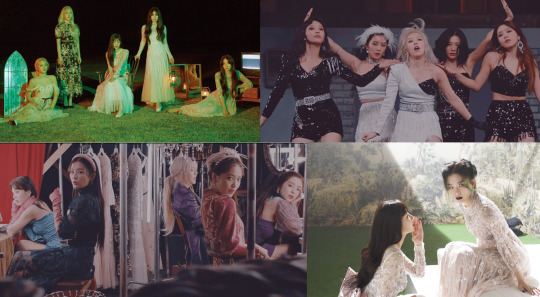
If it was a darker and more somber look that Fate wanted, there was a way to make it actually appealing. While it still feels a liiitle too grown up and elegant for Winx, (maybe this author is biased, as a full proponent for the Y2K fun) Psycho makes a very compelling argument for a witchy, mysterious, fairy tale-esque show that could look scrumptious and definitely not boring, or even a gorgeous example of what the witches in Cloud Tower could look like. Black and white, dark green, pastel blue and pops of jewel tones make Psycho's color palette. To add interest to the understated colors, the styling is heavy on textures; We see plenty of stonework, intricate embroidery, tassels, lace on lace on lace, feathers, bows, opera gloves and lots of glitter. All of that is offset by bold, dark makeup, leather accents and eerie cinematography. Needle & Thread, Marchesa Notte and Self Portrait lend their hyper feminine and intricately detailed tulle gowns, juxtaposed with the creepiness of the lyrics and the dark backgrounds; their deep berry and green fairy tale looks are built with pieces from Zara to Nina Ricci to Dolce & Gabbana to Alexander McQueen.
Red Velvet’s more edgy styling for 2018's Bad Boy would also not feel out of place on the Trix.
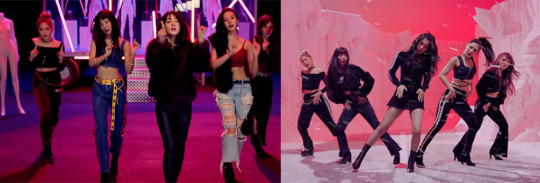
2. IZ*ONE - Fiesta
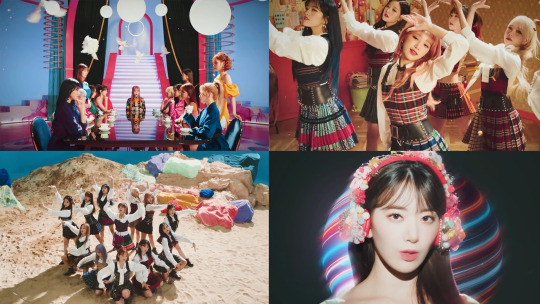
IZ*ONE kicked off 2020 with sweet and fun Fiesta. The MV features rooms with mismatched décor that go from retro to space opera, rocky faux landscapes that feel other worldly, and visual effects that would look perfect on the back of a transformation sequence. Mirroring the set design, the girls wear various outfits by sustainable up and coming brand Chopova Lowena. Their signature skirts made with discarded and repurposed fabrics give a cool and interesting twist on a schoolgirl look that would look very sweet for a band of school fairies that occasionally go off to save the world. Also, wouldn't those bedazzled headphones look great on Musa's fairy outfit?
1. Aespa - Black Mamba and Next Level

Aespa is what fans call a monster rookie. With only three music videos under their belt, they still have some of the most visually interesting work in the industry right now. Their concept is very tied in with high tech, featuring even AI avatars of each member, packaged in a glitzy, fantastical and futuristic aesthetic, candy pop meets cyberpunk. I think I’ve exhausted ways to say that is exactly what a perfect Winx adaptation should feature.
Their debut smash hit, 2020’s Black Mamba is truly a perfect moodboard for live action Winx. Wearing a sequined and colorful mix and match of Dollskill, Gucci, Didu and Balenciaga to a backdrop that features some alien fairy forest realness, a pyschedelic fever dream, rooms straight out of a Y2K catalog or donning lime green and black techwear inside a metro fighting the "black mamba", Aespa look through and through the part of fashion loving fairies who save the world together, while looking fierce, stylish and, most importantly, interesting.
The styling and the sets jump seamlessly from more casual colorful fits with blouses, shirts and baggy pants to barren, darkly lit backgrounds and fringe-and-glitter heavy pieces necessary to fight giant snakes, in a way so fitting to transformation outfits for magical girls we could cry.

In their third MV, 2021's Next Level, the cyber in their concept is taken up a notch (get it. because Next Level-), set to a futuristic urbanscape intersped with a planet made of crystals and the ocasional alien fauna popping up again. We get treated to Monse, The 2nd Skin Co., Johanna Ortiz and The Attico styled to fairy princess standards, sporty sky racers and a white and sequined group styling that is top ten fairy busy saving the world uniform material, or maybe even a specialist worthy getup.
This particular look from Ningning is so Techna that it almost feels as if it's mocking Netflix.
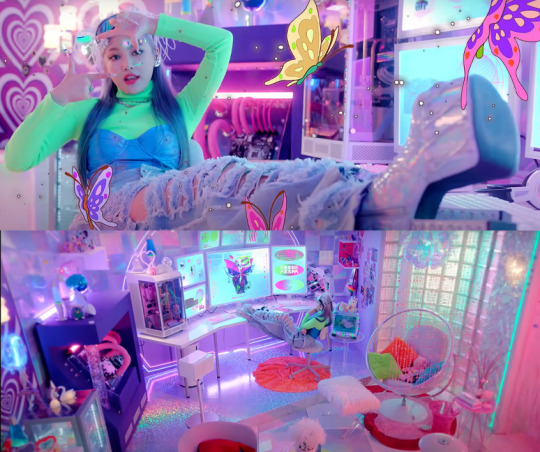
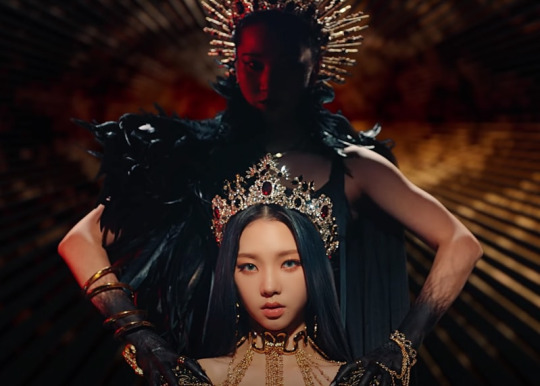
And doesn’t this Karina trapped inside the "black mamba" in Alexander McQueen feel like a perfect Dark Bloom moment?
These are only a few examples of interesting and creative designs that are in line with what a live action Winx Club should have given us. There are so many more I could list, even among other TV Shows, like Sex Education and even polemic dark Euphoria, that know how to have fun with style and design without losing the depth of their stories. In the end, it's hard to justify why Fate creators even wanted to make an adaptation that didn't even try to capture the heart of its source material, and all we can do is watch one more "Restyling Fate: The Winx Saga" video on Youtube whilst mildly dreading season 2.
#winx#winx club#fate the winx saga#fate: the winx saga#tv#tv/movies#cartoons#k-pop#kpop#red velvet#aespa#iz*one#fashion#costume design#art direction
192 notes
·
View notes
Text
Cutting Hair as Punishment in the Twilight Saga
Okay, I’ve been trying to organize my thoughts around this into a sort-of-essay format for a while, because I find it disturbingly mean-spirited: Meyer has a pattern of using hair-cutting as a form of punishment for characters, especially female characters, who fail to embrace Bella and the Cullens with open arms. I’m talking particularly about Leah and Lauren, both of whom, while not outright antagonists like Victoria or James, are situated along with Rosalie as “against” Bella throughout the series. The Quileute pack, meanwhile, is situated largely “against” the Cullens, meaning Jacob and the rest of the pack get the Haircut of Shame, too.
(Also, I’ve been creeping through @panlight ‘s blog because I thought she had a recent post relating to this -- I was probably thinking of this submission and her addendum, which does discuss Meyer’s “punishment” of certain characters, but that post was about characters suffering for not waiting for True Love, or daring to do the Devil’s Tango before marriage. Still, it’s on-theme and very much worth reading, like all her stuff!)
So here’s the general outline: first I’m gonna talk about the shapeshifters and how their overall lack of choice frames cutting their hair as something forced on them and therefore punitive. Then I’m going to discuss Meyer’s FAQ response where she reveals that Lauren was tricked into cutting off most of her hair over the summer before New Moon, and how this adds an extra fun misogynistic element to the hair-cutting theme with respect to Lauren and Leah. I also use way too many words to do it, sorry.
Punishment | The Shapeshifters Are Given No Other Option
I don’t have the background or knowledge to discuss the significance of long hair to indigenous culture and identity in detail, and my understanding is that different tribes ascribe different meanings to it. What I’ve read it about it suggests that, generally, long hair represents strength of one’s individual spirit and of the community. It’s a source of pride, and is only cut off voluntarily in extraordinary circumstances, often as an expression of grief, or to mark a significant life change.
This sort of works in the context of the shapeshifters all cutting their hair -- phasing into a giant wolf, discovering the existence of the supernatural, and assuming the role of protectors is a major life event for these characters. But the negative associations make it a troubling choice on Meyer’s part, and that’s without even getting into the problem of her imposing her own worldbuilding onto the legends and culture of a real tribe. Because of the lack of choice involved in becoming a shapeshifter, the whole situation feels like a scenario in which the Quileute characters have their hair forcibly cut -- a degrading and traumatic act that (depending on their particular tribal belief) might symbolically sever them from their sense of cultural identity and connection with the rest of their tribe.
It all kind of begs the question: why does Meyer even have shapeshifting work this way? What narrative utility is there in having the length of their hair in human form determine the length of their fur as wolves, thereby compelling the shapeshifters to cut it so it isn’t a physical impediment? It’s another sign of the changes in Jacob, sure, but he’s already being uncharacteristically cold and distant, plus suddenly has the physique of a fit twenty-five-year-old; Bella already knows something’s very wrong. His short hair is just another jarring thing for Bella to notice and mourn, like the loss of Jacob’s “baby face” and general sunniness.
It does work as a symbolic thing, representing another sacrifice Jacob has to make and the change in how he now has to perceive himself -- but he’s already got a literal giant wolf form to represent that change in identity/self-perception. Forcing him to cut his hair too just feels like piling on. My argument here, which I hope will be supported when I discuss Lauren and Leah further in, is that it’s not just piling on, but actively punitive -- because much like Leah and Lauren are “against” Bella, the pack at large is “against” the Cullens pretty much through the end of the series.
The Quileute pack is definitely not a Cullen fanclub. The entire purpose of their existence is to destroy vampires, and the truce they have with the Cullens isn’t friendly. They still don’t particularly like or trust the Cullens even after allying with them in Eclipse, and in Breaking Dawn Sam is fully prepared to go to war against them to enforce the treaty. Bella expresses frustration with Jacob and the pack for not appreciating the Cullens more, yet is curiously less willing to scold Alice, Edward, or Rosalie when they call the Quileutes dogs and complain about their smell. (I think she might reprimand Edward for it at some point, but I don’t remember the exact passage.) Bella even starts throwing around “dog” and “mutt” as an insult herself -- I think we know whose side ol’ “Switzerland” is on, here, and whose side Meyer is on as well. The Quileutes aren’t exactly enemies, and in fact are crucial to the Cullens’ survival in both the newborn and Volutri conflicts, but they’re punished nonetheless because they aren’t wholeheartedly Team Cullen from the get-go.
So to explain why I’m so convinced that there’s a link between hair-cutting and punishment in particular, let’s talk about Lauren. There’s a definite gendered element to it this time, too -- by being tricked into cutting her hair, Lauren isn’t just diminished/shamed, but rendered (*thunderclap*) unfeminine.
Lauren Was Rude To Bella Like Twice, Let’s Humiliate Her
I think Meyer’s answer to the question “What happened to Lauren’s hair?” on her FAQ page speaks for itself:
Ha ha. I had fun imagining this one—I only wished that it had fit into the book somewhere. Lauren fell victim to the “model discovered in the mall” scam. An alleged modeling agent approached Lauren in a mall in Victoria, B.C., and told her she was a natural model. Lauren ate it up. The agent told her that if she did something edgy with her hair, and took some high quality head shots, her future was assured. Lauren followed the instructions—dropping fifteen grand on the pictures taken by the agent’s partner—and waited for her career to begin. She’s still waiting. Snort.
It’s pretty obvious that this was done spitefully. Here’s the list of Lauren’s crimes against humanity Bella at this point in the series: 1) she was jealous of the attention Bella was getting as the new girl; 2) she talked behind Bella’s back once, saying Bella might as well just sit with the Cullens now (and she isn’t wrong); 3) she eyed Bella “scornfully” the day of the La Push beach trip; and perhaps most damningly, 4) she’s blonde.
Post-haircut, she has the gall not to be thrilled that Bella’s deigning to speak to the lowly non-Cullens again, then sides with Jessica after Bella uses Jessica to make a point to her dad, is shitty company, and then risks getting them both raped and murdered in Port Angeles so she could get off on her hallucination of Edward’s voice.
I think it’s pretty common knowledge that long hair is tied to patriarchal notions of femininity and attractiveness. Women with short hair are still derided for being ugly, or assumed to be lesbians in a derogatory sense, or simply considered less feminine and therefore less desirable/worthy (because a woman’s worth depends on her desirability, after all). For many women and girls, losing their long hair -- whether because of illness, or gum getting stuck in it, or whatever -- is very upsetting and a hard blow to their self-esteem. Just look at Alice as an example of Traumatic Short Hair; her hair was shorn like that because she received electroshock “treatments” in an asylum. (Although in Alice’s case, I don’t think her having short hair is punishment, but a facet of the traumatic backstory all female characters in Twilight have to have for some reason. Plus, she started the series with short hair, which distinguishes her from the pack and Lauren, who were tricked or compelled into cutting their long hair during the series.)
But Lauren’s so bitchy, so she deserves it, right? Ha ha, she was mean to Bella and cared about her appearance too much, so now she’s ~ugly!
Leah Has It the Worst and It Makes Me Want To Burn Everything
The misogynistic aspect of hair-cutting as punishment is taken up to like, twelve with Leah. Not only does she suffer for being “against” the Cullens along with the rest of the pack (and Bella, too, so extra sinning), but she suffers uniquely for being the only female shapeshifter. A bunch of teenage boys regularly see her naked body against her will. Her previously devoted boyfriend imprints on her cousin/best friend, Sam dumps her and can’t even explain why, and the whole pack -- including her own brother -- resents her for being upset about it, even though she can’t help the lack of mental privacy. Because of that same lack of mental privacy, she has to hear every gripe the boys have about her, plus every enthralled thought Sam has about Emily while she’s still deeply wounded by their breakup.
She blames herself for her dad’s death, because she phased at the wrong time. We don’t get any indication that her fellow shapeshifters or the elders are trying to reassure her otherwise.
And of course, because she’s a shapeshifter, she has to cut her hair. In addition, because Leah’s a woman, this has the same misogynistic connotations as it did with Lauren. In Leah’s case, though, the de-feminization is compounded by her sudden infertility. It’s clear that Leah attaches her sense of womanhood to her fertility, rightly or wrongly -- she bitterly calls herself a “genetic dead end” in Breaking Dawn and thinks of herself as a freak. She feels like there must be something wrong with her, some un-womanly flaw, that made her one of the shapeshifters at all.
Then, just when Jacob starts to see her as a human being worthy of compassion, he imprints on Renesmee and doesn’t give a shit about anyone or anything else anymore. No more bonding with Leah, no blooming friendship to help her heal and come to terms with the new realities of her life. (This is one of those dropped threads that aggravate me to no end -- what was the point of having Leah opening up to Jacob, or starting Jacob on the path of realizing he was being a dick to her this whole time and that she’s a person with value, if he was just going to spend the rest of the book as Renesmee’s love-zombie and never think about it again? Disgusting.)
Leah was a lot more forgiving of Jacob than he deserved at that point in the story, for all the good it did her -- I think she’s mentioned maybe once in Book 3 of Breaking Dawn. At least she got her god-tier moment of yelling at a deranged, pregnant Bella Swan.
Speaking of Bella...
I’m just going to note, for no particular reason, that in Breaking Dawn we get to hear explicitly that Bella’s got hair that falls “almost to her waist” and that she looks like “a freaking supermodel” because she’s so “beautiful and pale.” It just strikes me as a telling contrast at this point.
#twilight renaissance#i stared too long and the twilight abyss gazed back#leah clearwater#lauren mallory#jacob black#the wolf pack#long post#i felt myself getting petty about bella okay -- i'm aware it's happening but i have no self control#i also know i sidestepped the racial element to this and it's because i don't feel qualified to speak on it#so any additions from more knowledgeable people on that score are much appreciated
84 notes
·
View notes
Text
Why I Am So Conflicted On ReVice? (Episode 32 Checkpoint)
So Kamen Rider ReVice has been airing and i’ve been watching it week to week for my Tokusatsu Podcast TWIT. For the most part i’ve been enjoying it a lot but there’s little things here and there that add up for me to put the show down for me a few pegs so I want to blab about a few problems I have with ReVice along with the things I’m really into.
Pro Number 1: ReVice is a Compelling Duo
Something about the last two Kamen Rider series (Zero One and Saber) that I noticed was that my favorite characters didn’t end up being the protagonist. Sure I still think Aruto and Touma are good characters but they weren’t the star of there self tilted show which bugged me in a nitpicky way. However ReVice decides to give the titular of Kamen Rider Revi (Ikki) and Vice a lot of great development and banter with one another.
Vice took sometime to vibe with (especially given that his VA is a racist jerk) but he quickly became a really fun dude who could bring actual pathos to scenes. Ikki is a charming guy who can bring the heroic speeches a Kamen Rider is known for but still has his own doubts and turmoil to overcome which physically manifests in Vice being apart of him.
Con Number 1: Secondary Blues
Secondary Riders have often been fan favorite characters for modern Kamen Rider shows with Vulcan and Blades from Zero One and Saber respectively often being seen as the best parts of their shows and sadly the same can’t be said for ReVice. Daji has a great start as his Demon Kagero/Kamen Rider Evil is a joy to watch but after Daji becomes Live things go downhill for his character.
There’s some great little moments like with Kagero coming back a few times (the scene where he defends his sister with his belt and talks about curry is the peak of his character and I mean this unironically) but Holy Live arc felt so hollow. Some say it’s because it only had one episode but I disagree. I think the main problem is that there wasn’t really a strong message to go with Live vs Evil into Holy Live like with ReVice’s Magma or Thunder Gale forms. It just felt like “We have to fight for the sake of fighting” with no important lesson to be learned.
Not to mention unlike the other characters, Daji just seems the most plain in terms of personality outside of his Kagero persona which would normally be fine but the lack of focus he gets in the show doesn’t help me endear to him.
Pro Number 2: Kamen Rider Solved Sexism
Sakura/Kamen Rider Jeanne is probably the best part of the show and the most innovative aspect of it to the Kamen Rider franchise. The head writer for the series, Hanta Kinoshita, kept pushing to include a female Rider for this show even wanting a women to play the titular role for this series and he made sure to give Sakura not just a legitimately good arc for a female Kamen Rider (where the bar is set incredibly low mind you) but a good arc for a character in general.
While her first attempt at a transformation failed, it’s only to confront her weakness which manifests in the marketability cute demon Lovekov once she does transform. I like to think of that plot point as a mini commentary on how Toei executives think female Riders are useless but Sakura overcoming the perceptions to prove em wrong. Even after her debut she’s still active in the plot via her rivalry with Aguilera, and learning about the creator of her Belt, The Weekend so she’s always being challenged. Probably the only complaint I have of her is that her belt is locked behind Premium Bandai instead of a proper retail release...speaking of.
Con(ish) Number 2: The Show Hates Hiromi
I call this a Con(ish) because Hiromi starts off great. Despite not getting a focus episode till his trilogy of episodes, he gets all these neat bits of characterization and progress in the background about his beliefs and fears which lead up to his trilogy which are good episodes...up until the ending where his “death” is the most comically anti climax thing I've seen in awhile.
Yeah he’s not dead but the way we learn about why he’s not dead is just out of nowhere. We don’t even see his face in the episode where he is confirmed alive and kickin. This is probably to get us poor fools to watch the specials something ReVice has had a problem with between this and the Vail special. I mean ReVice has had MOSTLY good side content (the HBV was awful minus the Build form fight) so I guess it’s fine but I wish it was in the main show to begin with. Hoping Hiromi can get back on his feet in time for the final arc.
Wrap Up
That’s some of the ReVice thoughts I have at the moment. I could get into more but maybe for a later date when the show finishes. I just did this to articulate my conflicted thoughts on ReVice. The show is good and I would recommend it but in my five years as a Kamen Rider fan, you can get fatigued, cynical, and start to notice patterns that may annoy you which is why it’s important to take breaks and experience other media in the meantime. Anyway i don’t know how to end this blog so...subscribe to my YouTube channel:
https://www.youtube.com/channel/UCF3w6-RAiok95mbro-VXB-g
#kamen rider#kamen rider revice#kamen rider evil#vice#kamen rider vice#kamen rider jeanne#kamen rider demons
11 notes
·
View notes
Text
Jeanne, Vanitas and Agency
From the little I’ve dipped my toes into it, the VnC fandom seems pretty heated regarding Jeanne as a character. In drastic situations, I’ve seen accusations of misogyny based solely on someone’s comments on their feelings about Jeanne... a single character. And while yes, critiques can certainly be rooted in misogyny (must women be strong all the time? must they be submissive?), I think it’s important to consider not just the character herself, but how the story treats her and why we’re making the critiques we are.
Given that points of view in the fandom are so polarized, I’m going back to canon--to the text itself--to orient this essay. In particular, I’m going to focus on the point of agency--the freedom to make one’s own decisions about one’s self and one’s course of action. This goes beyond just Jeanne’s background as a borreau, trained to fight and follow orders. Agency is also consequential in her relationships with other characters and with the story as a whole.
(Content warning for discussion of abuse dynamics, and brief mentions of sexual assault.)
--
It’s natural to start off with Jeanne’s first appearance in the story: alongside Luca, she’s introduced as a new agent of conflict with Noe and Vanitas’s budding alliance. In fact, she is the one who initiates the physical altercation with Noe and Vanitas, while Luca is still trying to talk them into giving him the Book of Vanitas:
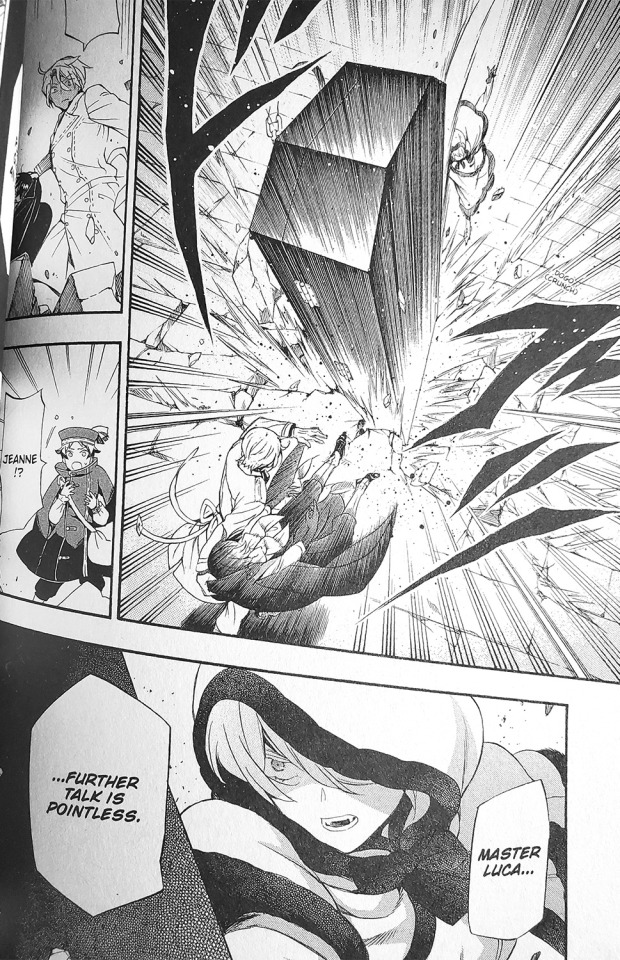
Aesthetically and conceptually, she’s introduced as an active element of the story. At this point, the “forced kiss” scene during the initial fight seems more like a fluke, a comment on Vanitas’s personality (and willingness to do despicable things to get what he wants) rather than Jeanne’s.
That brings me to why I found it so jarring when colored art of her that was subsequently revealed: that agency fell away to portray a visually more passive air.
In the existing full-color art we have of Jeanne, she’s more static in her environment, looking towards the viewer but with a face that looks rather blank, even meek. Specifically I want to point out this wallpaper, which I obtained from the official site fairly early on in Vanitas’s serialization (December 2016), in contrast to another piece of official art that was released of Noe and Vanitas with Memoire 11, around the same time:
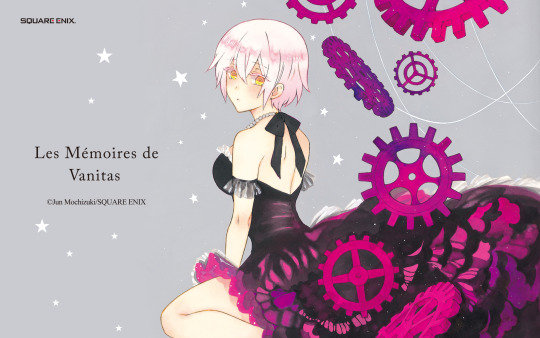
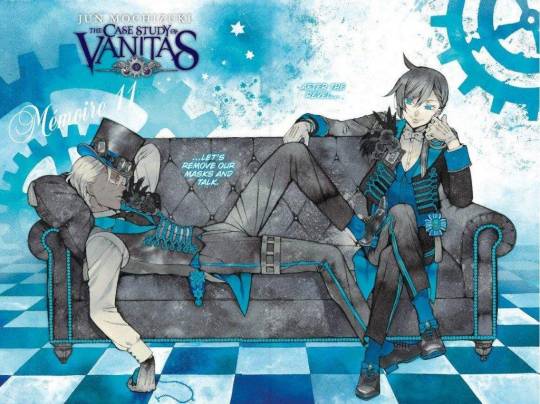
In both cases, the characters are posed intentionally, rather than actively doing something. And, they’re aware of the viewer’s gaze to some extent. However, Jeanne has her back turned to the viewer, and her expression is more idealized and ambiguous. Meanwhile, Noe and Vanitas are rather assertive: their expressions are more intentionally focused, and they seem to know their situation in the artwork. Jeanne is simply passive, very nearly objectified.
...Yeah, maybe this is just my art background speaking. But I also notice something similar happening in other official colored pieces of Jeanne, such as the cover of volume 4.
By this point in the story, lack of agency has become an even more significant element in Jeanne’s character arc: we learn that she’s been cursed. Not only is she unable to speak of the curse, it’s also in direct opposition to one of her primary character motivations, to protect Luca and those she cares about. Due to her uncontrollable urge to kill and drink blood, Jeanne fears that she’ll unintentionally hurt the very people she’s trying to protect.

Jeanne’s involvement with Vanitas also unfortunately comes with a sacrifice of her own agency. Seeing that she’s been cursed, Vanitas demands that she drinks blood from no one but him in exchange for keeping her secret. He further establishes her sense of reliance on him by promising that if he ever does see her lose control, he’ll kill her (so that she doesn’t harm Luca). Whether he’s simply a smitten 18-year-old who doesn’t yet know how to conduct healthy relationships, or whether he’s crafty and intentionally drawing Jeanne in further--or even whether it’s a mix of both--this idea of Vanitas’s control over her is reflected in the cover art for volume 4.
At this point, considering the literal events of the story, Jeanne’s passiveness is not only visual, but symbolic. In this illustration, Vanitas’s hand is grabbing Jeanne by her bow, and functionally by her neck: she’s being dragged along against her will, with little means of escape. And she looks at the viewer with a surprisingly similar expression to the previous illustration: one that communicates little say in the situation.
This matches up with their literal relationship in the story itself. Knowing she’s cursed, Vanitas is establishing her exclusive reliance on him, in exchange for keeping important secrets from others with whom she’s close (i.e. threatening to drive a wedge into their relationship). He’s already pushed himself upon her physically with clearly no warning or enjoyment from her. Yes, he’s been kind. And when Dominique trails Vanitas and Jeanne on their date, she notes that Jeanne is “terribly weak against any sort of kindness.” But in spite of some more “cute” and candid moments, the overall dynamic between Jeanne and Vanitas is far from genuine kindness. Returning to how Vanitas garnered an edge over her in their initial fight--with taunting, carefully chosen words--I would phrase it more as that Jeanne, a borreau trained to kill and inexperienced with matters of feelings, is particularly susceptible to emotional manipulation. (There’s more than a little irony in this internal comment from Jeanne, at the beginning of her date with Vanitas:)
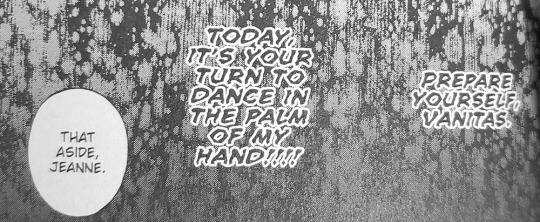
Jeanne’s relationship with Vanitas becoming important isn’t, in isolation, inherently an issue. In most cases, it’s fun to see how a character who usually appears unshakeable is rounded out when we see them at their more vulnerable times. What makes me feel squicked out and worried on Jeanne’s behalf is how it’s executed, considering how it works in opposition to how she was introduced as a character, and how Jeanne and Vanitas’s relationship harkens back to known dynamics of abuse.
In other words, my discomfort is not at Jeanne herself for falling for Vanitas and his tactics. It’s at how she’s introduced with a promise of agency in her own story, and that agency is subsequently taken away in how she’s portrayed in official art, and in plot points as the story progresses. It’s at how their relationship begins to fall into a harmful template perpetuated by rape culture, where a man forces himself upon a woman at first, but she is shown to eventually enjoy those advances even when unwanted. I had high hopes for Jeanne as a character developed with her own agency, motives (and yes, for cool fight scenes that WLW like me can admire), and so far, Vanitas’s effect on her has threatened to overshadow these. This is where I think sections of the fandom throwing accusations back and forth of each other being misogynistic, on the grounds of criticizing Jeanne and her relationship with Vanitas, fail to see the wider issue.
Of course, eliciting this sort of discomfort may even be the whole point. Jun Mochizuki is known for putting her characters through tragic and painful situations, and her previous work Pandora Hearts is rife with unstable, imbalanced, and otherwise less-than-perfect relationships. But even without this background knowledge, a decisive scene that convinces me of the intentionality of this purpose is one I’ve written about before: Jeanne’s internal fantasy as she’s left unattended by Luca and loses herself in a storybook.

Here, Jeanne fantasizes about being the agent in her own story, a position that, the art reminds us, is often occupied by a male character such as a prince. Ultimately, this progression looks innocent and could serve to remind us of Jeanne’s more vulnerable, innocuous side. But including it here in the story could also serve as foreshadowing, a contrast to what Jeanne’s situation is like for her in reality. (If you want to read more on this panel specifically, my analysis is in the source link of this post!)
Essentially, critiquing Jeanne as a character requires more nuance than simply judging her individual characteristics. It’s necessary to also take into account the way that the story treats her and her relationships with others and other forces in the story. Not just is she allowed to be soft and emotional, but what consequences does this have for her, and how do the story elements lead the reader to feel about her being soft?
Personally, I think she’s very likeable as a character--her situation just seems unfair, and I feel like she deserves so much better than Vanitas and his schemes. I mean, she could easily destroy him with her gauntlet, and he knows it! But, then, it’s Jun Mochizuki. We should probably expect to be feeling pain and pity for her characters. Still, the relationship between Jeanne and Vanitas has always kinda rubbed me the wrong way, and I think this pretty much sums up why.
103 notes
·
View notes
Note
I always have a trouble enjoying Matt’s story knowing who he will end up with tbh. What are your favorite and least favorite relationships from the books? I’ve always been a little iffy on nyneave and lan but have warmed up to it as time goes on.
Hi there!
In general I'm not a fan of the canon ships, lol, mostly because I feel that none of the people who are so much in love really know each other. I mean love at first sight is all nice and well but it seems to happen too often and especially the women tend to be completely bonkers about the men they fall for.
The only exception is Nynaeve and Lan. Yes this is a bit of 'love at first sight' but it has that little extra that they fall deeper the better they come to know each other and they actually understand each other far better than any of the other pairings. Nynaeve letting Lan ride to his destiny and then ensuring he won't ride alone is iconic and shows how well she understands him.
As for the other canon ships. Egwene and Gawyn don't know each other. I really dislike the Rand harem (it was not meant as a polycule by the author) - it's such a male fantasy! - I want to throttle Perrin and Faile for not talking to each other (although they are cute in The Dragon Reborn), we don't see Birgitte / Gaidal (which could be interesting). Siuan/ Gareth have the worst basis with him ordering her around and Moiraine / Thom makes me cringe because there is no way that Moiraine would offer to give up being Aes Sedai for anyone.
I like some of the background pairings : Gaul and Chiad, Amys and Rhuarc, Androl and Pevara (at least these fall in love after getting to know each other).
What I really like is many of the friendships we see - and some of them have a queer subtext that the author probably did not intend.
Well Siuraine is canon and I would have loved for it to stay canon because the other options are just so bad.
I love the Egwene / Aviendha friendship, I love Elayne / Mat gradually coming to respect each other. I adore Nynaeve / Elayne shenanigans and I have a very soft spot for whatever it is that Elayne and Aviendha as well as Mat and Rand have going on.
It's my headcanon that Elayne and Aviendha are more in love with each other than with Rand and even if you read Mat / Rand as platonic: they really know each other and have each other's backs.
These friendships are often deeper and more meaningful to the characters than the romantic relationship. Just think about how much Elayne cares what Avi thinks of her (and later Mat).
I've come to the conclusion that RJ had just no idea how to write romance. Because if these relationships are what he thinks a hetero relationship should be he had some very peculiar notions - including the idea that women and men don't talk to each other and don't understand each other and that is just sad.
Thanks!
#anon ask#wheel of time#wot book spoilers#ships in WoT#lanaeve#is the only valid canon ship#Elayne /Aviendha is good#and Mat/Elayne#but neither are canon
8 notes
·
View notes
Text
Tom Hardy Movies rated least to most queer
I made a list of some Tom Hardy movies and I rated them based on my own, non-specific criteria about what makes a movie queer. Results below the cut.
(Some films not included, because I haven’t watched them yet, because Mr Hardy’s only in them for a few minutes, because the subject matter doesn’t lend itself to this list, or because I just don’t want’em here. TV series also not included. The list is organised into both groups and ratings, because I’m doing The Most.)
Movies are divided into four groups and rated from 0 – 10 on the Queer-Scale, scroll down to the bottom if you want the ratings without the commentary.
Disclaimer: This list is subjective. Don’t come at me because I didn’t rate Inception higher, Nolan himself is as queer as cargo shorts.
1. This movie would make more sense if it were queer
If this movie were queer it… might not become a perfect film all of a sudden, but it’d make a hell of a lot more sense than what’s actually going on. With an occasional dose of “are the cis-straights okay?”
This Means War (2012): So Chris Pine and Tom Hardy are ostensibly both in love with Reese Witherspoon, but say “I love you” to each other pretty much constantly throughout the movie and their friendship is often presented as a domestic partnership. Cool, cool, cooool.
Queer Rating: 2 out of 10. This movie hate-crimed me by having Tom Hardy literally spell out his relationship with Chris Pine, only for the script to then have him say… “can you imagine all that… but with a woman…” Later on the movie explicitly denies polyamory is possible. Fuck this film.
The Dark Knight Rises (2012): Batman movies should always be queer. Mr. Hardy’s the only one who acceptably camps it up, despite Nolan’s best attempts to make him “acceptably gruff.” No matter what you do, Bane is a massive daddy in a mask and thanks to Mr Hardy’s honestly iconic fucking speech pattern in this film, it goes from pretty atrociously straight to just queer enough to imagine a future where Robert Pattinson plays batman and maybe adopts a bunch of kids.

(the only truly decent mask in this franchise tbh)
Queer Rating: 3 out of 10. Mr Hardy’s back is the one that’s actually broken carrying any semblance of fun in this overly long movie all on his own.
Lawless (2012): Wow, this really was the year of the not-queer-enough, wasn’t it? Look, it’s “based on a real story,” but it’s also a movie and movies don’t need to stick to the truth, and this one certainly doesn’t. Was the guy queer in real life? I don’t know. But that doesn’t matter, what matters is that it’s just kind of an eh movie and maybe being queer would add something to it. One of those “but why make someone queer? because it’s always more interesting to do so,” movies.
Queer Rating: 3 out of 10. It’s just not queer. But Tom Hardy wears cardigans and described his character as a “mother figure,” which adds an interesting dynamic to him.
2. Actually Queer but in a homophobic way
Tom Hardy plays a canonically queer character, yaaay. The whole movie contains a strange sense of the director being too not-queer to actually engage with that and everything around him is almost aggressively straight, noooo.
RocknRolla (2008): Honestly this movie has the funniest coming out scene ever + that familiar undertone of “all these manly men secretly want to fuck each other” is only heightened by one of them actually being gay and in love with his best friend. It’s such a fucking… it’s such a movie. Personally I find Mark Strong, Idris Elba, Thandie Newton, and, of course, Tom Hardy to be really hot in it, so that’s a plus. There’s a scene in which Strong’s character teaches another gangster how to do a proper backhand. It’s really gay of him. Also slow-dancing at a gay club. Butler’s character needs to get himself together, you really don’t think 2008 Tom Hardy is hot? Mate.
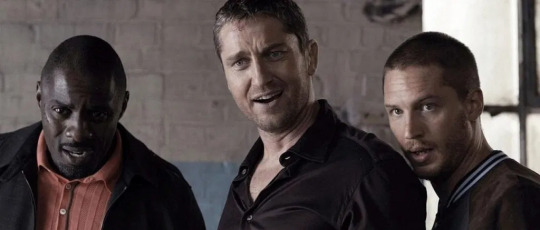
(left to right: functional queer, disaster queer, distinguished queer)
Queer Rating: 6 out of 10, for having an actual gay character who is played by Tom Hardy doing a sexy phonecall voice to another guy, but then there’s that feeling you can’t shake that the whole movie is vaguely uncomfortable about it, like a family member awkwardly patting you on the shoulder after they found out you were queer second-hand, but they’ve still got 50 years of bias to unlearn. Also Thandie Newton is killed, fuck that noise.
Legend (2015): If I had a nickle for the amount of times Tom Hardy’s played a gay gangster, I’d have two nickles. Which isn’t a lot, but weird that it happened twice (looks at Peaky Blinders and thinks it ought to be three times). I’ve watched Legend three times and every time it just… loses me. And because this is a biased list, I’ll only specifically mention that it fails to make Ron’s queerness anything but a way for him to shock others. Gangsters could be gay? Gasp! On the upside Tom Hardy has so much sexual tension with everyone in this movie, including himself (why would you do that? Asks Ron, bemused. Because I can’t kill you, no matter how much I fucking want to, hisses a blood-soaked Reggie right into his ear. It’s hot).
Queer rating: 5 out of 10 because the film is just not very queer for a movie with several queer men in it.
3. Straight as a forced family dinner
It’s straight.
Locke (2013): He’s a married man who had an affair and trying to deal with the fallout of it. This isn’t a spoiler for most of the movie, it’s a pretty neat movie where we look at Tom Hardy having a bit of a mental breakdown and taking lots of phonecalls (my personal hell). Is it queer? Not in the slightest.
Queer Rating: 2 out of 10 for Hardy’s face being in almost every shot.
The Revenant (2015): Yeah, yeah, DeCaprio’s and Hardy’s characters are obsessed with each other, yeah it’s a man’s world where the only women are dead wife, kidnapped sexually assaulted native princess, or background whore, yeah, they fight each other and there’s a ton of grunting, but also… I just fucking don’t like this movie. The thin line where a storyline like this one becomes queer might be crossed for others, but not for me. Fuck these guys and their stupid bear fights.
Queer rating: 3 out of 10 for it being about dirty men in the middle of nowhere (but you could just watch Brokeback Mountain or The Lighthouse or God’s Own Country or any Mad Max, or, or, or…)
4. Queer? Queer. Queer? … Queer…
The plots, aesthetics and/or characters played by Tom Hardy lend themselves to a queer reading, even if there is no overt intention towards queerness. Often this is because of a deliberate lack of heterosexual and/or cisgender writing, which in this day and age is still pretty uncommon not to include within a plot.
Inception (2010): Okay, I don’t even need to write about the added “darling,” or the “go to sleep Mr Eames.” I don’t need to go on about the absolutely bonkers amount of fanfiction written for Eames and Arthur, based on a few minutes of film and a boatload of chemistry. It’s queer.
Queer Rating: 7 out of 10, because the actual plot of the film isn’t very queer, but between the Arthur/Eames dynamic and Elliot Page, Nolan was really given a gift he didn’t deserve.
Warrior (2011): Okay, so first off, this might be my favourite Tom Hardy film, at least some part of my brain is fixated on it at almost all times and I’m considering watching it for the third time in two weeks. I don’t only consider it queer based on Mr. Hardy’s character, although he has no romantic or sexual interest and could be read as aroace, but because of the themes, especially those surrounding said character, who is coded as a caregiver to women and through close emotional connections to men. It’s got possibly unintentional deconstructions of masculinity and two men (brothers) who need to forgive each other and can only do so through the catharsis of violence. It speaks to me as a transmasc with several cis brothers, struggling with my own masculinity. It’s not at all written for me, but I find myself all over it. I could talk about this movie forever.
Queer Rating: 8 out of 10. I’m not allowed to say any more or I’ll never stop writing about it. I love you Tommy…
The Drop (2014): Bob’s lack of sexual and/or romantic interest in Naomi is so strange to her that she doesn’t know what he would want from her otherwise. Bob really just wants to raise a dog with her (and also forgiveness for past sins). Bob is such a rare ace and possibly aro coded character, it really throws me every time I watch this film how obvious it is. Bonus points for also being autistic-coded and not in the stereotypical ways.
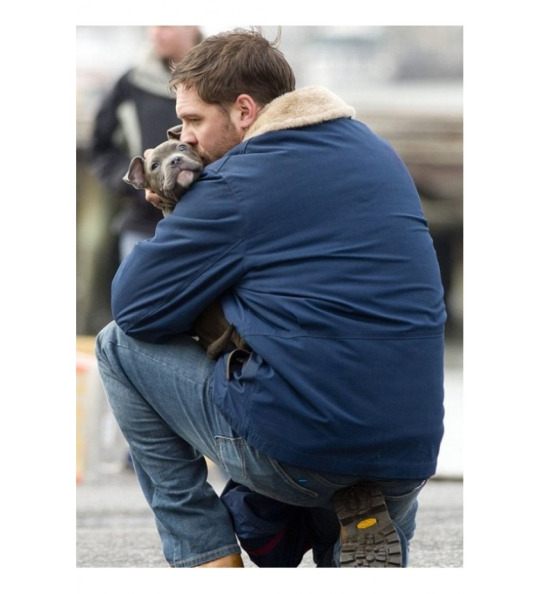
(Tom Hardy’s most challenging role: pretending he doesn’t know dogs)
Queer Rating: 9 out of 10 because it’s so fucking rare to see ace and aro coded characters that aren’t, you know…. serial killers. Also Tom Hardy adopts a puppy and has a very cute, kinda lispy voice. How often does Tom Hardy play softer men like this?
Mad Max: Fury Road (2015): Very deliberately no sexual or romantic writing included in Max’s and Furiosa’s relationship. Sure, there’s not a lot of time for that in the post-apocalyptic wasteland, but it was also done with a purpose! “It was always going to be two warriors on par, starting off with very little respect for each other and ending up with a massive respect for each other.” - Charlize Theron. “So of course they meet, of course there’s a relationship, an unspoken understanding. A recognition.” - Tom Hardy.
Queer Rating: 9 out of 10. It’s not just the characters, but the world and it’s apocalyptic BDSM leather scene, the questions it asks about sustainability and about people as tools, and the found family. It’s about overcoming violence through multiple kinds of love. And it’s about watching a guy playing flame-thrower guitar. What could be queerer?
Venom (2018): Talented, brilliant, incredible, amazing, show stopping, spectacular, never the same… No, but Eddie is queer. The only question is whether the sequel will acknowledge that aspect or not, but even if not. Even if it manages to straightly bypass the reality of a symbiotic relationship with a genderless? genderfluid? being from another world that is linked to you down to your very cells and understands you more intimately than any other person possibly could… even if all that: Eddie is queer. Venom and Eddie are in a relationship. Any relationship Eddie ever enters into will automatically become a thrupple. He makes out with Venom in the movie! Eddie is queer.
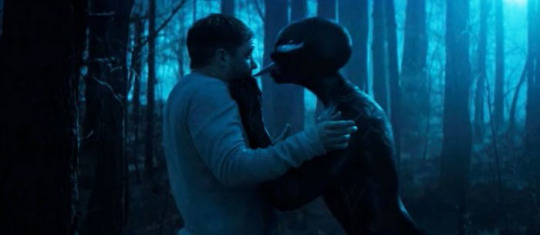
(aw yeah that tongue is going down his throat)
Queer Rating: 9.5 out of 10, because it’s still coded by the creators in the language of bromance (hey, bro, is it gay if we’re physically and emotionally closer than any other people on earth?), but the movie is so, so camp and Mr Hardy’s acting choices are beautiful – the screaming? The lispy soft voice and lack of taking up space? The lobster tank? The only people who don’t know how queer this is are the people making it apparently. Fingers crossed for that sequel!
Hon. mentions:
Star Trek: Nemesis (2002): Star Trek – even at it’s worst (especially at its worst?) – is camp af + Hardy is a straight-up baby in this film.
Bronson (2008): It’s about a real person who’s still alive, so I won’t comment on the actual man. However the film seems to code the character Bronson along an ace line and also has genderqueering Vaudeville. Someone let Tom Hardy do more of whatever was going on in those stage-bits.
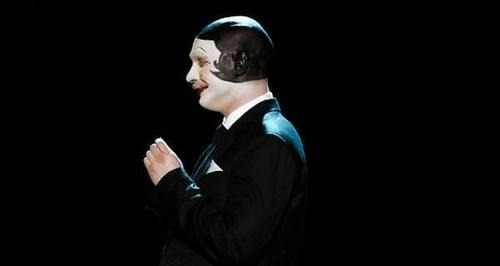
(this right here: this the good shit)
Tinker Tailor Soldier Spy (2011): Another ensemble piece not massively about Hardy’s character, but it’s a movie that centers around queerness in a strange, depressing way. Tom Hardy’s character isn’t queer. Colin Firth and Mark Strong are though. The book makes me cry.
Peaky Blinders (2013-): Because it’s a TV series I left it out. There’s a lot of straight nonsense going on there, but Alfie Solomens is gay. There’s nothing in the series that disputes that and plenty that lends itself to the reading.
Dunkirk (2017): Tom Hardy plays an RAF pilot in a deep emotional connection with the other main RAF pilot. That’s immediately gay. However he’s not in the movie much because of the way it’s constructed, so I left it off.
Queer Ratings (least to most)
No queer to be found here traveller:
This Means War: 2 out of 10 - illegal movie, Tom Hardy swore he wouldn’t do another rom-com after
Locke: 2 out of 10 - straight Welshman and his straight problems. He pretty though
Lawless: 3 out of 10 - cardigan-Hardy being a mother-hen, but very straight for all that
The Dark Knight Rises: 3 out of 10 - a superhero movie that doesn’t deserve Mr Hardy’s camp talents (unlike Venom)
The Revenant: 3 out of 10 - doesn’t give me what I want out of a movie full of dirty, bearded men
Queer but we deserve more:
Legend: 5 out of 10 - timid homosexuality, considering the source material.
RocknRolla: 6 out of 10 - hey bro, is it gay if we kill the only female lead in our massive ensemble cast
The queerest of Hardy’s:
Inception: 7 out of 10 - Elliot Page and JGL kissing was an all-around terrible choice that made no sense, we know the truth, Nolan
Warrior: 8 out of 10 - I’m still crying, Edgerton’s crying, Hardy’s crying, we’re all crying, and I think that’s really emotionally healthy and queer of us
Mad Max: Fury Road: 9 out of 10 - non-romantic love in the time of BDSM post-apocalyptic wastelands is something that can actually be so personal
The Drop: 9 out of 10 - “Fucking punk. Go out to dinner dressed like you're still in you living room! You wear those big hippity-hoppity clown shoes! You speak to women terribly! You treat them despicably! You hurt harmless dogs that can't defend themselves! I'm tired of you man. I'm tired of you. You embarrass me!”
Venom: 9.5 out of 10 - Sometimes a relationship is an anxious reporter, the sentient goo inhabiting his body, his kinda-ex-girlfriend and her new doctor boyfriend, and I think that’s beautiful
#tom hardy#mad max: fury road#venom 2018#inception#rocknrolla#warrior 2011#legend 2015#the drop 2014#the revenant#the dark knight rises#lawless 2012#locke#this means war
228 notes
·
View notes
Text
Tried to make a brief summary of the issues of Mass Effect Andromeda’s handling of queer men and how it relates to why we’re (broad use here) upset with the Legendary Edition failing to provide better representation than the originals, and it kinda turned in to what amounts to an open letter for BioWare.
So, what the heck, here it is.
A little personal background. I spent my high school life completely in the closet. After graduating, I had a new computer and the opportunity to play a new game. The game chosen was BioWare’s Jade Empire. Still a fairly recent release, and I was a big fan of Star Wars Knights of the Old Republic, also by BioWare. So, being a young gay man, still uncomfortable and uncertain of who I was, I was very excited when I got to play this game that would allow me to play a gay romance, a romance that featured two men. I burned through two playthroughs of the game within less than a week, enjoying that rush of acknowledgement that yes, gay guys could be the hero. It was a massive affirmation for me at the time, something that said that my sexuality was not going to prevent me from being the hero, which legitimately was a message that I felt like most media was giving me to that point, because gay men barely appeared in anything other than guest roles for an episode or two on a TV show, but certainly not in video games. That game, that experience... I’ve said for years that it had cemented me as a BioWare fan for life.
If I say that now, it is a statement with a few caveats.
The history of the failure of Mass Effect 1 and Mass Effect 2 to provide any male/male romances is well documented. I was excited, very eager to romance Kaidan Alenko in Mass Effect 3. But even then, I noticed that there were things that were lacking in the romance. It was noticeable, for instance, that the basic dialogue between male Shepard and female Shepard was unchanged, if either was starting a new romance with Kaidan. The thing that always felt... WRONG about that was that if I’d had the option to begin a romance with him in the first game, I would have. Yet there’s not even a bit of dialogue that even references that inability, no comment of “I didn’t think you were available,” or anything of the sort, nothing to say that, say, Shepard was interested in Kaidan at the time, but didn’t believe he’d be receptive, didn’t want to damage their friendship, something of the sort. There was even a cut in the romance scene, where female Shepard will sit in Kaidan’s lap before being lifted up and carried to the bed, but with male Shepard and Kaidan, just fades to black. And then in the Citadel DLC, while all the other pairings walked in to the casino arm in arm, male Shepard and Kaidan are leaving plenty of room between them. There’s also the absence of any cuddling as they return to the Normandy.
To say nothing of the lack of Steve Cortez during the story segments of Citadel – he is not part of the big team entrance to the apartment, just spontaneously appears in the lounge room. He doesn’t participate in the briefings, and he is not a casino date, despite being part of the assembled team. Cortez also suffers from the fact that his romance spends so much time on how he needs to move on from the death of his husband, Shepard can come across as predatory towards him, trying to push him out of his grief and his pants. Due to the lateness of his arrival in the story, in game three, as opposed to game one or two, there is significantly less time to establish him as a person – beyond his past as a pilot and the death of his husband, we gain almost no concept of his personality or personal history.
I bring all of this up to help set the stage of what was expected when Mass Effect Andromeda was nearing release. Mass Effect had been full of problems of representation of queer men specifically (not that they were perfect on the count of female/female relationships either, because there’s plenty to talk about there, but as I’m not a lesbian or bisexual woman, I don’t feel comfortable talking about their experiences for them). While there were flaws, Dragon Age, what is often considered Mass Effect’s sister franchise, HAD managed to provide male/male romances in every iteration of that franchise.
In fact, considering that Dragon Age’s most recent installment, Dragon Age Inquisition, had been put out with a lot of fanfare about the first gay male companion, who was considered rather popular in the fandom, and the game itself receiving the Game of the Year award that year, indicating that, if there was any risk in the business sense of providing representation of queer men, it was negligible at most in the bottom line of that game, the attitude of a lot of gay men in the lead up to Andromeda’s release was some variation of “okay, Mass Effect has been flawed, but BioWare’s learned from their past mistakes, and they’re coming off the heels of a hugely successful game that had a gay character whose gayness was front and center in his storyline... We can expect that things will be fine, and we don’t have to worry.” That was the dominant attitude I found in a lot of my queer-oriented spaces.
But we started getting uncomfortable as the developers remained cagey about romance options in Andromeda – there were Twitter responses to “we’re concerned about Mass Effect’s history of gay representation, we would like to know about the options” that came out as “we checked and yep! They’re there!” These responses came across as flippant and even tone-deaf – the reason that the question was being asked was because of prior failures to be included, and not simply a desire to get all the details before launch.
As the trailers started coming out, the questions continued from the fans, and the response from the developers... continued to be uncomfortable. When asked directly for a listing of romances prior to release, the response was that the developers wanted players to learn as they played, that “the fun is in experiencing it!” This was a specific response when it was learned that the romance options could be flirted with regardless of orientation, but they would shut it down. Despite the fact that the trailers DID include content from certain romances – specifically, the male Ryder/Cora and male Ryder/Peebee romances.
This was uncomfortable for a lot of queer players like myself because it spoke to a lack of consideration of what it is like to be queer. In many places, it is a serious question of safety to even put yourself out there to find a partner, to flirt with someone openly unless you are already certain that there is a chance for a positive response. There are places where a queer person flirting with the wrong person can get them harassed, assaulted, even killed for doing so. Even in the safety of a virtual construct of video games, these are honed instincts that queer people have developed. And no matter how many times we would say this to the developers, no one seemed to understand. Likewise, the fact that the trailers felt free to show off heterosexual romances, but not queer ones felt... questionable.
Then, finally, firm details started coming out, and... There were problems. Early data-mining said that there was an even split of romances between orientations. But there was a bit of discomfort around the reveal that the gay characters, Suvi and Gil, were limited to the ship, rather than being companions who would accompany Ryder on missions. There is a history of companions being given more involved storylines and involvement than secondary characters. It also didn’t help the disappointment from queer people who’d been eager for Cora or Liam as romances, who were firmly established as straight (Cora herself had a popular lesbian following).
That discomfort increased when it came out further that, ACTUALLY, Jaal would not be available for Male Ryder. This caused a lot of upset. Now it was a case where there was NO M/M squadmate romance option. This on top of the group of fans who were uncomfortable with the idea that, in a sci-fi series, gay men couldn’t romance an alien, while this had become a staple of the series, considering Liara, the character from a species described as equivalent to Star Trek green-skinned Orion girls, had been available for straight men and lesbian/bi women from ME1, and straight women got in on the act with Garrus and Thane in ME2, on top of straight men also getting Tali.
This got worse when the achievement listing for the game was released and there was an achievement for “romancing three different characters.��� Meaning that it was absolutely impossible for a gay man to play the game and get this achievement without playing a sexuality other than his own.
This is why I led with my experience with Jade Empire, why it was so affirming to me. Because to hear all this, ten years later, to see what had been so affirming to me a decade prior be functionally dismissed, be shown to take a secondary position at best... It hurt.
And the game proper did not help that feeling at all.
So first we meet Gil Brodie. Engineer of the Tempest. One of the first things we learn about him is that he has a close friendship with a woman named Jill. And then he immediately tells us that one) she is a fertility specialist, and two) she “says [he’s] part of the problem” because he won’t have kids the natural way. This is immediately setting off red flags to me – I can think of plenty of my friendships where we give one another grief for various things, but I would never think of introducing any of them to someone else with that fact. So my reflexive thought in this situation is “what kind of a friend is this really?”
And then, as the game goes on... This is the only thing that Gil’s conversations involve, the prospect of having kids. We do not learn much more about him, just have him talking about considering the idea. The lock-in for his romance requires Ryder to meet Jill, who Gil again says that she will talk his ear off about his “civic duty” to reproduce, a fact that makes those earlier red flags wave higher and more furiously, because who DOES that to a total stranger? And this is passed off as being “charming.” This leads to the culmination of the romance, where Gil says that Jill has decided she wants to get pregnant and she wants Gil to be the dad.
There’s... A LOT going on here, so let me work through this. First, one of the few things Gil says as a bit of establishing his character is that he is impulsive, that he joined the Andromeda Initiative, the journey from the Milky Way galaxy to the Andromeda galaxy without really thinking through what it would mean, that it was a one-way journey with no way to back out once he’d gotten there. So this is already saying to me that this is not a person who really SHOULD be a parent, at least at this point in his life.
We also get a couple of emails from him in-game that paint him as putting in thirty-six hour workdays into the engines on the Tempest, that he cares about and puts a lot of time into those engines. So when I think about him as a father, I see him having to give up something he’s deeply passionate about to do it, because the Tempest is certainly no place to raise a child – they can’t exactly put a playpen in the cargo hold, for example.
This would be one of the first things that I would think of as a discussion element, but... it’s not there. All that we get is a couple of casual comments about how Gil should know that bringing a child into the world is a big thing, something that shouldn’t be done lightly. But this is framed as Ryder questioning Gil’s fitness to be a parent at all, rather than questioning if he’s thinking this through and having considered this enough to be ready to take on this responsibility, or if it’s even something that he even wants.
Because that’s the other big thing here – this is not Gil’s idea. This is not something that he makes clear is his desire. No, it’s Jill who has decided that she wants to get pregnant and use Gil’s sperm. For all that he matters in this whole thing, he might as well be a turkey baster. He’s basically an accessory in his own story, because he goes in to this with all the passion of a math equation: “The Andromeda Initiative is a colonization effort. Therefore, the idea is to have babies. Therefore, I should find some way to reproduce.” This isn’t him having a passion or desire to have kids, just it being “something you do.”
This is, genuinely, a failure to understand the character who was being written. Gil’s writing reeks of having been written by someone who does not know what they are talking about. There is an element to the gay experience that is not innate but learned. When we realize that having children is not a thing that will just happen, that if we want this to happen, it will require a lot of additional steps, there are many who will simply say “this isn’t for me, this is more work than I’m willing to put in to for this.”
Now, Gil could have been someone who had decided it was worth it, but that butts up against the idea of him being impulsive, that he doesn’t think things through. There is no time given to focusing on the reason he decides this is the right choice for him, to the point that many players felt that this was not Gil’s decision but something that Jill was pushing, that she expected him to jump on her command. Because we have so little of Gil, as a character and an individual, but plenty of him talking up her, this “friendship” feels toxic to many.
Just about everyone I have ever spoken with about Gil is deeply uncomfortable that literally, the only way that he will not have a child at this point is if a romanced Ryder stops him – if I am playing a game where I don’t romance him, I actively just stop interacting with him at a certain point so that this never comes up, because this does not come across as happy. It comes across as forcing a gay man into a heteronormative experience to satisfy some traditional idea of “man and woman, raising kids.”
And, as the cherry on top, if you do tell Gil that you’re not comfortable having kids – a very real thing, whether gay or straight – then, unlike other romances, Gil and Ryder do not share a kiss at the finale of the game. And, during the last conversations on Meridian, the only thing Gil even brings up is Jill being pregnant, whether or not it’s his child.
This is what “representation of gay men” amounted to in Mass Effect Andromeda. A homophobic story that was about a gay experience written by someone who is not a part of this community and does not know or understand the experience personally, going through the motions of development when really, all that is cared about is the end result. To say that most of the gay men I know who have played this game find this homophobic is to undersell the point.
It doesn’t help that, of all the Tempest romances, Gil also clocks in with the least amount of romance exclusive material – a few flirts, the romance lock in and scene, and being able to stop Gil from having kids. Other than that, his friendship and his romance are virtually identical.
Speaking of, the romance scene consists of a make out session that fades to black, before coming back in with Ryder and Gil, shot from about shoulders up, briefly wrapping up their conversation that preceded the fade to black. This is noteworthy when the heterosexual romances between Ryder and their human love interests, as well as Peebee and Jaal, the former having a similar body model to naked human women, just blue, and Jaal, who is naked at other points in the game, have much more involved romance scenes – Cora’s in specific received special attention.
All of this, individually, may have just been reflective of time crunch and other external pressures – we all understand the realities of game development, that for all the ambitions that go in, when the deadlines are nearing, something has to give. But taken collectively... The kindest question is to ask why all of the “give” happened in regards to the gay man?
The end result with Gil honestly feels like he was written in response to the bad faith arguments that had come up in the period after the name for the game was revealed and it was made clear that the game would follow a colonization effort. There were a contingent of people who said that “there shouldn’t be gay people coming along, a colonization effort needs to reproduce.” This is a bad faith argument from homophobes, trying to justify why they don’t want gay people in “their” games. In answering their question, the question they only “ask” in order to explain why they don’t want to have gay people in the game without saying that, it comes across as catering the gay content for a heterosexual audience. It should go without saying that this is a bad position to take.
So, that’s Gil. What about Reyes? Well, Reyes himself is bound to a single planet, which, again, points to a minimizing of how much content he will even get, since his content can only be accessed on this single planet. Likewise, Reyes, as a character, is someone who falls in to several old, tired tropes with regards to bisexual men – he is a shady, untrustworthy character, in this instance literally a criminal, meant to be evocative of the “dashing rogue” archetype. This is a characterization that has often been BioWare’s go-to with regards to bisexual men, because we see this archetype drawn on in Jade Empire’s Sky, Dragon Age Origins’ Zevran, Dragon Age 2’s Anders, and even elements exist in Dragon Age Inquisition’s Dorian (even if he is a gay man). It’s a well that BioWare has frequently tapped when it comes to a romance option for queer men, to the point that it starts to feel like BioWare in general believes that this IS what queer men are.
There’s also the questionable portrayal of Reyes that leads to a description of the trope “the depraved bisexual,” an explicitly bisexual character who uses sex and sexuality as a manipulative tool, that they treat others as simply there to be their toys. Over in Dragon Age Inquisition, one of the romance options was specifically NOT made bisexual in order to avoid this trope, but Reyes himself seems to be a candidate for that trope all the same.
All this, and, again, the romance options for gay men were unequal to those for everyone else. This prompted the campaign #MakeJaalBi – Jaal was, notably, the character initially assumed to be the bisexual male companion, and on release, his romance was heterosexual exclusive. But datamining revealed that there was code for him to be romanced by male Ryder. Indeed, on release, it was noteworthy that Jaal could not even be flirted with by male Ryder. Liam had a distinct turndown for male Ryder, a couple of them, depending on when Ryder flirts with him. Jaal had no such turndown.
And this worked. BioWare released the patch for Andromeda that gave Jaal a bisexual romance. However, this was the only change that Mass Effect Andromeda received in regards to the issues of the romances before support for the game ended. While it was seen as an improvement, it was also questioned why this was the only change, when... Well, I spent the better part of two pages outlining the problems of Gil’s portrayal.
(I feel I would be remiss to not mention there was also a character, Hainley Abrams, who would, upon interacting with her, proceed to deadname herself to Ryder, as if that is the only way to establish that a transgender person is trans. This was also changed in a patch after the trans community complained, and, in conjunction with the above, led more than a few people to wonder if the Andromeda script had been looked over by any queer sensitivity readers, given the earlier issues with Gil. This does go out of the scope of everything else in this discussion, but it is worth mentioning.)
When Mac Walters says players will talk about how Shepard is each of theirs, that every individual player approaches Shepard as being “their” Shepard, he isn’t wrong. He says the characters, and the relationships we have with the characters is the heart and soul of the series, he isn’t wrong. And yet... When I play the trilogy, my heart and soul are being torn apart, because I do not get to see myself in the trilogy. I am not there in this story, at least for two thirds of the way. And in that third that I am there, I feel like I am cared about less than my counterparts who are heterosexual.
The idea that “making” characters available for same sex romance changes them is like saying that there is some inherent difference in a person because of their sexualities. While it’s true that the experiences of queer people does offer different perspectives on matters, it does not fundamentally alter the person, the individual that we are. It does not change our heart and soul. Restoring the bisexuality of characters like Jack, Jacob, Ashley, Thane, or Tali is not changing who they are. Making Kaidan bisexual in ME3 did not change who he was, and restoring a romance between him and male Shepard in ME1 would not change him either.
Every game has some cut content surrounding queer content specifically, and a great deal of that content is specifically for gay players like myself. I said at the beginning that I once thought of myself as a BioWare fan for life, but that now comes with caveats. The caveats are pretty simple – while the games produced by BioWare once felt affirming, now they feel like they’re only grudgingly allowing me to be there. That if I must be there, I should just take the scraps I’m given and be content with that, rather than being treated as an equal.
I like to think that this is not the message that the people at BioWare wish to impart to their players. I like to believe BioWare’s statements of wanting to be an inclusive and welcoming environment for their players, regardless of gender, race, sexuality, orientation, whatever identity and label one chooses. But based on the experience of the last four games, of the Legendary Edition perpetuating the homophobia of over a decade ago... I have a hard time believing that.
BioWare games once made me feel like I was equal to the straight heroes across my media. Unfortunately, I don’t feel that way about their games anymore. Not when, after having the opportunity to restore the bisexuality of Kaidan – of multiple characters, really – in the Legendary Edition, I am still being told that offering representation for people like me is something that only comes grudgingly.
And if that’s what I see now... What does it say about what the future of the franchise will offer? If every game in this series involves fighting for content that, in particular, heterosexual players will see offered as the rule, what motivates me to want to continue to be invested and involved in this franchise?
#bioware critical#dg rants#another angry queer rant#make mass effect inclusive#make mele inclusive#makemeleinclusive
37 notes
·
View notes
Note
i just read your article about kate and jo and i dont think i couldve put it better myself. ive been thinking it through and honestly come to the conclusion that jed just..isn't that great at writing women (or just somehow forgot for this season bc lindsay denton and even roz huntley were compelling female characters). if you look at every single female character this season, they were all kind of criminally underdeveloped- chloe served as no more than a plot device, as did farida, patty c came in all guns blazing and then..did nothing, and even jo's storyline fizzled out after her interview. kinda seems to me looking back that he often starts semi-emotional plots for kate (which lets be honest has always just been the one note plotline about her husband and son) and then abandons them to focus on some irrelevant aspect of steve's life instead. she arguably had the most interesting emotional storyline this season with her connection to jo, but seems like steve's painkillers were more emotional to jed!
I read this comment aloud to my girlfriend last night and we had a long, really interesting conversation about Jed Mercurio's treatment of female characters :) :) thank you so much for your words!
You are SO right. Jed creates compelling female characters, yet fails to arrest them emotionally in any way, so they float and then eventually sink under another unnecessary and pointless storyline. This happens to basically all of the female characters you mentioned, in some way or another - they just fade into the background. So much wasted potential gone, so under-utilised.
Chloe was an actual WOLF. A pure leader of the pack and a diamond. She was so motivated, so clinical, she always hit the mark and delivered the goods. She could've soared. They brought up this Christopher Thompson case which could've tackled institutionalised racism, and it didn't go anywhere. What was the significance of showing the case, revealing the faces of those 5 white boy thugs, if they were going to drop it straight after? It would’ve been pretty special to see Chloe step up and lead the way on this case, being one of the few black women on the show. She stood in perfect contrast to Steve this season - when he was hitting ignore on his emails from occupational health and looking HAGGARD trying to chat up Steph in Merseyside, Chloe single-handedly cracked a ten-year long case. And yet Jed had the audacity to include a scene of Steve and Kate at the pub clinking their pints like, "well done mate." FOR WHAT? IT WAS ALL CHLOE. YOU DID NOTHING.
Without being too controversial I have always found Steve's character to be overwhelmingly one-dimensional. We never get to see his emotions, really. He is canonically boring. I don't care if he has a bad back - if that is the extent of his storyline (which it basically was) and it doesn't lead to a big reveal in the Fourth Man case, why should I care? The female characters are all like bright spitting fireworks in comparison to him. He needs those jazzy waistcoats to spice him up, and even that doesn't really work. (Sorry to Steve fans.)
I also 100% agree about Farida Jatri. She served as a plot storyline only and then dropped her pronto. It would've been interesting to hear what her thoughts were about getting set up by Jo. What's she going on to do next? What was she referring to when she said 'you don't know what she's capable of?' What about all the other women that work in AC-12?
For queer women particularly, Jed clearly doesn’t know what to do with them. The palpable queer dynamic between Kate and Jo could not have been handled any worse. Not only did he disregard their goodbye + any connection HE HIMSELF had embedded into their storyline in the finale, he also tainted Kate’s character by insinuating that she was capable of manipulating Jo when she was clearly emotionally and physically vulnerable (at risk of being killed), and she was constantly dealing with past trauma. We see Kate act this way with Gates in series 1, but it hits differently this time, given that Jo is the show’s first guest star who is a lesbian, the implications have far more wide reaching impact on our representation - it’s cruel and it was so unnecessary. Honestly what was the point?
The fact that hurts the most about all of this is no one from the Line of Duty cast and crew is talking about why they did this. They don't even realise how wrong it is?
#line of duty#kate fleming#steve arnott#flemson#jo davidson#line of duty series 6#vicky mcclure#kelly macdonald
35 notes
·
View notes
Photo
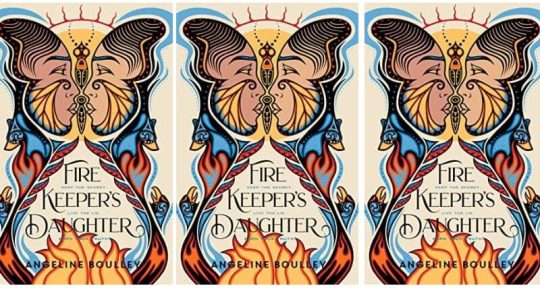
*As is usual with our discussions, there may be a few spoilers ahead, so beware.*
We all were incredibly excited to read Angeline Boulley's FIREKEEPER'S DAUGHTER when we first heard about it, so we decided to make it our second group discussion book for the year. Come join us!
As a biracial, unenrolled tribal member and the product of a scandal, eighteen-year-old Daunis Fontaine has never quite fit in, both in her hometown and on the nearby Ojibwe reservation. Daunis dreams of studying medicine, but when her family is struck by tragedy, she puts her future on hold to care for her fragile mother.
The only bright spot is meeting Jamie, the charming new recruit on her brother Levi’s hockey team. Yet even as Daunis falls for Jamie, certain details don’t add up and she senses the dashing hockey star is hiding something. Everything comes to light when Daunis witnesses a shocking murder, thrusting her into the heart of a criminal investigation.
Reluctantly, Daunis agrees to go undercover, but secretly pursues her own investigation, tracking down the criminals with her knowledge of chemistry and traditional medicine. But the deceptions—and deaths—keep piling up and soon the threat strikes too close to home.
Now, Daunis must learn what it means to be a strong Anishinaabe kwe (Ojibwe woman) and how far she'll go to protect her community, even if it tears apart the only world she’s ever known.
[Note: While we will not go into any great detail in this discussion, Firekeeper’s Daughter contains murder, suicide, kidnapping, sexual assault, addiction and drug use, racism, colorism, and death of parents/family members.
You can read an excerpt of the book here!]
Audrey: To get us started--let’s talk about this gorgeous cover! The cover art was created by Moses Lunham and designed by Rich Deas. The first thing I noticed when I got my copy of the book was that the two faces at the top had different skin tones. According to this interview, author Angeline Boulley says that “the different shades of the faces symbolizes Daunis claiming her biracial identity,” which is a major part of the book.
Jessica: The cover is so beautiful. It’s next to me on my desk right now and I can’t stop looking at it. Love how the cover ties into the themes of the book.
K. Imani: This cover is absolutely beautiful! I love the design of the faces looking like a butterfly as well as the bird and bear (I think) and the fire. There are so many subtle images in this cover that you can almost find something new each time. And the colors are so stunning. Like you Audrey, I noticed the faces had different skin tones which I found interesting and made me wonder what was going to happen in the book. Knowing the faces symbolize Daunis’s biracial identity now is powerful and really brings home the meaning of the book.
Crystal: I agree that the cover is gorgeous. In addition to the aspects of her physical appearance and physical identity, Daunis’ cultural identity is also displayed within the illustrations with bears representing her clan. In addition there are the birds like the one that guides her and the sun is in the background too which is from the story of the original Fire Keeper’s Daughter. The faces forming a butterfly is also just brilliant for a coming-of-age story. There’s so much to see. Each time I notice more.
Audrey: Daunis, our heroine, is on the older end of the YA protagonist spectrum at 18. She’s dealing with a lot of upheaval in her life, and things only get more complicated in short order. Something I really liked about Daunis was how often she thought about and evaluated what her responsibilities were--to her family, to her friends, to her community, and to herself. These sometimes complementary, sometimes competing, responsibilities strongly influenced her decisions.
Jessica: You mention the complementary and sometimes competing responsibilities -- that’s exactly it. I loved how her thought process was explored throughout the book in such a thorough and complex way. The way Daunis balances and reconciles the interests of her community with what the FBI wants from her and her quest for justice is laid out really clearly. Sometimes, narratives can tend toward simplistic, binary summations of the issues people, especially from marginalized communities, face -- but that’s just not the case, and Daunis really highlights that. To be honest, I was a little nervous at the introduction of law enforcement and the FBI, given the racism and oppression baked into these institutions, but the way Daunis navigates her interactions with them, plus the way other members of the community tell the truth about these institutions, really played out in such a nuanced way. (I really, really hope that the Netflix adaptation keeps these nuances and hard truths in the show, but I suspect that won’t be the case, unfortunately.)
K. Imani: I enjoyed that Daunis was 18 and on the cusp of adulthood. So many YA novels focus on the character’s high school life but a lot does happen and teens do grow and change a lot in that year after high school. Many have left home for college (that was me) or working full time and they are learning how to navigate a life that was not completely so structured. In addition to having to deal with changing friendships as people move away or just become busy. It’s a unique time and I loved that we got to spend time with Daunis as she was going through this change. She was learning how to become an adult in one of the most stressful ways possible, and sometimes I felt she was a little too idealistic, but I’m glad that she kept her truth throughout and was focused on helping her community in addition to helping the FBI. Her perspective helped keep the investigation grounded in what mattered which wouldn’t have happened if she wasn’t involved.
Crystal: Daunis balances a lot of responsibilities and really tries to follow what she’s learned from elders. She considers how her actions may affect all of her relatives within her family, clan, community, and beyond. Boulley embedded a lot of elder wisdom within Daunis’ inner dialogue such as thinking about the seventh generation when making decisions.
Audrey: One of the things that I really appreciated about Firekeeper’s Daughter was the depth of the setting and the characters in it. While Boulley says that Daunis’s tribe is fictionalized in the author note, it’s clear how much care and thought Boulley put into creating Daunis’s community. It’s filled with people who have complex histories (both within and between Native and non-Native groups), with differing opinions and prejudices and goals.
Jessica: This really highlights how important it is to have stories where cultures and communities aren’t portrayed as a monolith. It’s not just the right thing to do, it makes for a better and more accurate story. I read Firekeeper’s Daughter and watched the TV show Rutherford Falls back to back, which really drove home the power of depicting a community with nuance. (Also, sidebar: Highly recommend checking out Rutherford Falls, which does this really well.)
K. Imani: One of my favorite aspects of Firekeeper’s Daughter were the elders in Daunis’s tribe and how we got to hear many of their individual stories which showed the complexity of real life. I loved that Daunis listened to her elders, really took in their stories and learned from them. Her interactions with the elders greatly contributed to her growing sense of self and her desire to help her community. And this is where this novel being truly #ownvoices shines because of Boulley’s connection to her community that she took great care in making sure Daunis’s tribe felt real and authentic as well as culturally accurate. It was not full of stereotypes but filled with real people who had real lives and real stories. I was drawn into Daunis’s community and really cared about the people that made Daunis who she is and becomes.
Crystal: Like Jessica says, there is a lot of nuance here. When you have a wide variety of characters who are not simply good or bad, the story has more power and is definitely more believable. The people in our everyday lives are also complex and have a story if only we take the time to listen. This is what Daunis excels at with elders and others around her. She is paying attention and trying to connect with people. There is a lot of love throughout the book of many different types. The love is beautiful and yet also has some ugliness too in the betrayals. It’s not picture perfect and that makes it so much more real.
Audrey: Boulley tackles a lot of difficult topics in Firekeeper’s Daughter, especially ones that can hit hard on a community level. Much of the plot focuses on drug use and addiction, of course, but violence against Native women also has a significant impact on what happens in the book and affects multiple characters, including Daunis.
Crystal: Daunis and the other women are examples of the many, many, women who have been harmed in the past and the present. That’s not the whole story though. As Daunis is learning, there are many ways of being brave. Throughout the story, we see many women being strong and brave though at initial glance their actions may not seem to be either of those things. There is bravery in speaking out, but sometimes bravery requires something else. These women have done what they needed to do to survive or help their loved ones survive.
Audrey: Firekeeper’s Daughter has a complicated ending, and it left me thinking about two things. The first was how proud I was of Daunis and her character growth. There were a couple of times where she came across as very Not Like Other Girls (particularly with the hockey players’ girlfriends), but that changed over the course of the book. The second was grief at how many people and institutions failed Daunis and her community, both within and without. Just as one example, even though Daunis is a confidential informant for the FBI, the FBI doesn’t come out of this story as a Good Guy.
K. Imani: I was torn by the ending too. I so wanted justice for Daunis and Lily and for others who were murdered, but on the other hand life doesn’t always have a happy ending and I recognize that Boulley gave us that horribly realistic ending because the fight for missing and murdered Indigenous women continues and the fight for justice for Indigenous peoples. It was a heartbreaking reminder of a very real issue. On the other hand, I was so proud of Daunis as well. She was able to achieve her goals of helping out the FBI while staying true to herself and her community. She grew so much as a character and really found her place in her world.
Crystal: The ending gave me much to think about too. Daunis grew a lot as she worked through this complicated puzzle in her community. She learned much about herself and some of the assumptions folks have about others. I also really, really wanted justice, but unfortunately, would be unlikely in real life with our current justice system. I also found Jamie’s growth to be interesting. He is truly struggling with his own identity as an adopted child with Cherokee roots, but no Cherokee teachings or culture to turn to. I don’t know if a sequel or companion book is planned, but I would be interested in seeing more of their journeys whether their paths cross again or not.
Jessica: Audrey, thanks so much for leading this discussion! Now I have a question for you all -- what YA books by/about BIPOC are you reading right now?
For AAPI month, I’m rereading Turtle Under Ice by Juleah del Rosario. After that, I’m planning on reading The Ones We're Meant to Find by Joan He, Apple: Skin to the Core by Eric Gansworth, and Witches Steeped in Gold by Ciannon Smart! Yes, my TBR pile is excellent. :P
Audrey: Next up on my list are The Theft of Sunlight by Intisar Khanani, Forest of Stolen Girls by June Hur, and Simone Breaks All the Rules by Debbie Rigaud. I feel like that’s a pretty good mix of genres and authors right there!
K. Imani: Since I’m needing some inspiration for my vampire manuscript, I’m re-reading and new reading some vampire novels. Currently I am reading Fledgling by Octavia Butler then up next is Renee Ahdieh’s series The Beautiful and the sequel The Damned.
Crystal: I just re-read Saints & Misfits and then dove into the sequel Misfit in Love. S.K. Ali is an author that I really enjoy and I am loving it so far. Next up is American Betiya by Anuradha D. Rajurkar along with Love & Other Natural Disasters by Misa Sugiura. I also think my TBR is pretty stellar.
If you've had the chance to read FIREKEEPER'S DAUGHTER, please join in the discussion below! We'd love to hear what you think.
21 notes
·
View notes
Text
Star Trek Episode 1.24: This Side of Paradise
AKA Yet Another Creepy Utopia Planet
Our episode begins with the Enterprise heading in to orbit around an Earthy-looking planet named Omicron Ceti 3. Omicon Ceti is a real star, by the way—also known as Mira or Mira A, it’s a red giant and part of a binary star system with its sister Mira B. It’s not a real likely place to go looking for such a nice homey sort of planet, though, because Mira is a pulsating variable star, which means its size and brightness is constantly fluctuating, and it’s hard to evolve life when your sun keeps flickering like a neon sign in a noir movie all the time.
Uhura reports to Kirk that she’s been transmitting a contact signal every five minutes just as he ordered, but she’s only getting dead air in response. Kirk tells her to keep it up until they get into orbit, then moves on to talk to Spock. “There were one hundred fifty men, women and children in that colony,” he says. “What are the chances of survivors?”
Looks like the chances are, uh...not great. And by ‘not great’ I mean ‘nonexistent’. Spock explains that ‘Bertold rays’ are a recent enough discovery that there’s still a lot not known about them, but one thing that is for sure known is that exposure to these rays causes living animal tissue to disintegrate. Nasty. Evidently this planet is heavily exposed to these rays, because a group of colonists-- “Sandoval’s group”-- came here only three years ago and Spock says there’s no possibility they could have survived. Well why the heck would anyone build a colony in such a place? All Spock can say is “They knew there was a risk.”
Kirk questions whether they can risk sending a landing party down under such conditions, but Spock says the disintegration doesn’t start immediately, so they’ll be alright if they don’t stick around too long. The helmsman reports that they’ve successfully established orbit, and he’s found a settlement—or at least, something that was a settlement at one point. Kirk tells Spock to equip a landing party of five to accompany him down there, including a biologist and McCoy. That’s gonna be a fun mission briefing. “Yes, we're beaming down to a planet bombarded with deadly radiation, but no need to worry, crew, your tissues will probably only disintegrate a little bit."
Sometime later, the landing party—Kirk, Spock, McCoy, Sulu, a blueshirt and a goldshirt—materialize into a meadow near a dirt path and a picket fence. They’ve thoughtfully arranged themselves into a nice alternating pattern.
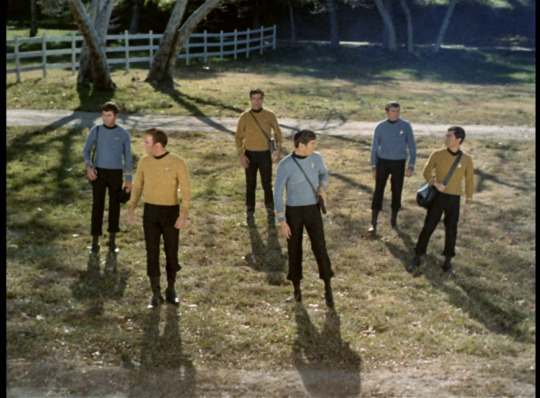
[ID: A shot of a sunny meadow with a dirt road, a few trees and a white picket fence in the background. Newly beamed down are six Enterprise crewmembers standing in two rows: in the front are Kirk and Spock, in the back are McCoy, a goldshirt, a blueshirt, and Sulu.]
The goldshirt, incidentally, is DeSalle, who we last saw back in The Squire of Gothos. The character was originally written for this story as Lt. Timothy Fletcher, but was changed to DeSalle after the production crew realized they’d cast an actor who had already appeared in the series. Yes, really. AGAIN. The blueshirt is Kelowitz, who showed up briefly in The Galileo Seven and Arena, and likewise started out as another character but was renamed after being cast. I don’t know how this situation managed to happen so often on TOS, but apparently it did. At least they both seem to have managed to hold onto more or less the same positions that they had the last time we saw them, a rare feat for any minor TOS crewmember.
The group walks forward towards some nearby farm buildings arranged around a dirt yard, with a horse-drawn cart sitting out in front of one of them. But there’s no horse to be seen, and no people either. They wander through the yard and over toward what looks like a paddock, but without any animals in it. Everything seems quite thoroughly deserted.
Kirk leans on the paddock fence and glumly muses, “Another dream that failed. There’s nothing sadder. It took these people a year to make the trip from Earth. They came all that way...and died.” Hold on, it took them a year? What, do they not give colony ships warp drives? Did they have to hitchhike here?
“Hardly that, sir,” someone says, and suddenly we see three men in green jumpsuits standing at the edge of the yard, looking very relaxed and also very not dead.
As the landing party all turn around to stare in shock the man in front strides forward and says, “Welcome to Omicron Ceti 3. I’m Elias Sandoval.” McCoy looks like he’s getting ready to spray the dude with holy water.
After the titles, we get a brief captain’s log to sum things up, just in case everyone forgot what happened during the commercial break:
“Captain’s Log, Stardate 3417.3. We thought our mission to Omicron Ceti 3 would be an unhappy one. We had expected to find no survivors of the agricultural colony there. Apparently, our information was incorrect.”
The colonists start happily shaking hands with the landing party—but happily as in “oh, it’s so nice to meet you” not “oh thank god you came to rescue us we’re all on the brink of death”. Sandoval says they haven’t seen anyone outside the colony since they left Earth four years ago, although they’ve been expecting someone to come by for a while. Apparently their subspace radio didn’t work right and they don’t have anyone who could “master its intricacies”. Now, I’m no expert on establishing colonies on alien planets, but ‘person who can work our only communication device’ does rather seem like a position you would want to make sure was filled before you left.
Kirk has to explain that they haven’t come to visit because of the dead radio. He does not explain why they did decide to come when they did. Spock’s comment about the colonists knowing there was a risk indicates that whether or not Bertold rays specifically were known about before the colonists left, they at least had reason to believe there was something dangerous about the planet. So why’d the Federation let them go and then wait another three years before sending anyone to check up on them? Eh, probably just another failing of twenty-third century space bureaucracy.
Sandoval’s not bothered about it, though. He tells Kirk that it doesn’t make much difference—the important thing is the party is here now and the colonists are happy to see them. Then he invites them on a tour of the settlement and casually strolls off, leaving the landing party to stand there and try to process what the hell they just witnessed.
“Pure speculation, just an educated guess...I’d say that man is alive,” McCoy says. Thanks Bones.
Spock says that his scans show that the planet is getting ray’d just as their reports indicated, so that’s not the issue. Under this intensity, the landing party could safely hang out here for a week if necessary, as per the usual Star Trek rule that you can be exposed to a deadly thing and be just fine up until the exact moment it kills you, but there’s a mighty big difference between a week and three years. Or as Kirk succinctly puts it, “These people shouldn’t be alive.”
“Is it possible they’re not?” Sulu asks. Great out of the box thinking there Sulu, love it.
Kirk takes a moment to consider that, which is fair—compared to the kind of weird shit they’ve encountered so far, the walking dead wouldn’t even stand out that much. But McCoy points out that when they shook hands with Sandoval, “His flesh was warm. He’s alive. There’s no doubt about that.” Spock fires back with a reminder that, “There’s no miracle connected with [Bertold rays], doctor, you know that. No cures, no serums, no antidotes. If a man is exposed long enough, he dies.” Okay dude, calm down, all McCoy said was “he’s alive” not “my god! Bertold rays have been fake all along! wake up sheeple!"
As Kirk points out, this whole debate is pretty pointless anyway for the moment—they’re arguing in a vacuum, and they’ll need more answers if they want to get anywhere. So they go to follow Sandoval, who leads them towards a nearby farm house, while a few colonists do various farm chores nearby. Sandoval explains that the colonists split into three groups, with forty-five people at this settlement and two more settlements elsewhere on the planet. Apparently they thought that arrangement would give each group a better chance for growth, since if some disaster struck one group the other two would probably still be alright.
“Omicron is an ideal agricultural planet,” he says. “We determined not to suffer the fate of the expeditions that went before us.” It’s rather vague what expeditions he’s referring to here, since at no other point in the episode are any previous attempts at settling Omicron Ceti 3 mentioned. But given that Sandoval specifically mentions the possibility of disease afflicting one group as a reason to split up, and Spock earlier said that Bertold rays were a recent discovery—and that the colonists knew coming to Omicron Ceti 3 was risky-- it seems possible that previous groups tried to settle the planet and, without knowing about the Bertold rays, mistook their effects for some kind of disease native to the planet. Of course that doesn’t explain why this group of colonists decided it would be a good idea to try to settle here again anyway, but if there’s one thing I’ve learned over the past few months, it’s that not everyone sees the possibility of dying to a terrible disease as a compelling reason to change their plans in any way.
As they stand in the farmhouse talking about this, a woman steps forward from another room in the house. She’s in soft focus, just in case we might forget she’s a woman, and instead of the green jumpsuit all the male colonists are wearing, she’s wearing green overalls over a lavender shirt, a combination that somehow manages to be an even worse fashion disaster than the jumpsuits themselves. She starts to say something to Sandoval, then stops in surprise as she sees the landing party. But for once the romance-o-vision isn’t for Kirk—it’s Spock that the camera zooms in on as the woman stares at him.
“Layla, come meet our guests,” Sandoval says cheerfully, oblivious to the wistfully romantic background music. He introduces her as Layla Colomi, their botanist. Layla says that she and Spock have met before, but “It’s been a long time.” Kirk gives Spock a bit of a side-eye for that, but Spock offers no details.
Well, all romantic tension aside, they do still have a mission to attend to here, as Kirk reminds Sandoval. Sandoval tells them to go ahead with any examinations or tests they want. “I think you’ll find our settlement an interesting one. Our philosophy is a simple one: that men should return to a less complicated life. We have few mechanical things here, no vehicles, no weapons. We have harmony here. Complete peace.” Oh yeah, that bodes well. Remember the last place we saw complete harmony and peace? At least that explains why everyone on this farm is using equipment straight out of Stardew Valley, which is presumably not the most advanced agricultural technology available by the twenty-third century. I’m not sure why Sandoval’s idea of a simpler lifestyle excludes vehicles, though. They’re not exactly the most recent thing on the timeline of human technological advancements.
Sandoval tells the landing party to make themselves at home, and they all head off. All except for Spock, who lingers just a few seconds more to give Layla a completely neutral look before walking away as well.
Everyone goes off to conduct their respective investigations. Sulu and Kelowitz wander through a yard over towards another farm building. Kelowitz isn’t sure what exactly they should be looking for, though. “Whatever doesn’t look right—whatever that is,” Sulu replies, climbing up to sit on a railing on the building’s porch. “When it comes to farms, I wouldn’t know what looked right or wrong if it were two feet from me.” I hope you enjoyed that line, because “didn’t grow up on a farm” is about all the backstory TOS is going to give us for Sulu until the movies.
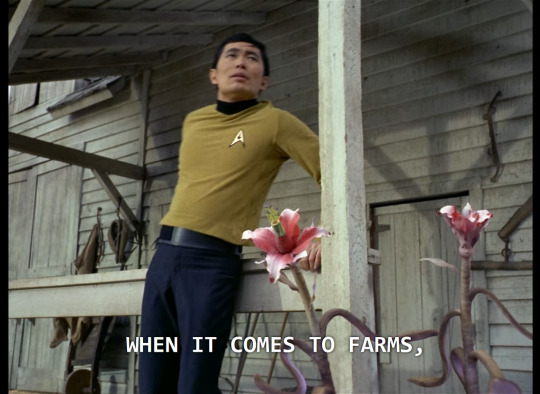
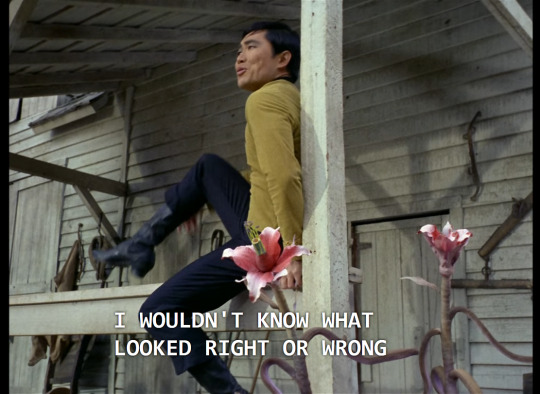
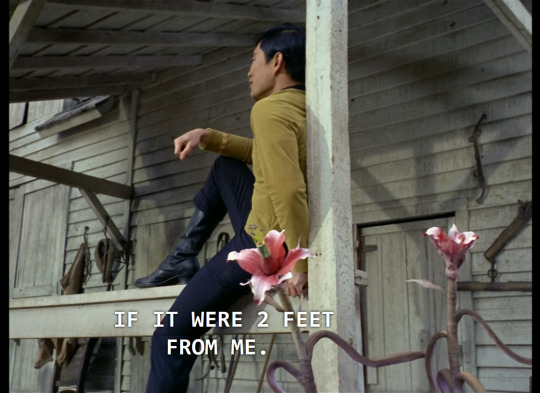
[ID: Three screenshots showing Sulu pulling himself up to sit on the railing of an old-fashioned farmhouse as he says, "When it comes to farms, I wouldn't know what looked right or wrong if it were two feet from me." Growing up from the ground nearby are two large plants with thick brownish-purple stems and large pink flowers on top.]
Hey Sulu, what's that about two feet from you? Oh well, I'm sure it's not important.
Kelowitz opens up a nearby barn and notes that there’s no cows there—in fact, the barn isn’t even built for cows, just for storage, and indeed it only looks big enough to be useful for holding cow, singular. Having a storage barn isn’t itself that weird, although the fact that there is nothing currently stored in the storage barn is a bit strange. But also, as Sulu points out, come to think of it, they haven’t seen any animals here, native or imported. No cows, no horses, no pigs, not even a dog. Which is a bit odd for an agricultural colony. They must have had or expected to have animals at some point—otherwise what was pulling that cart?
Back in the house, Sandoval is asking Layla about Spock (once again referred to as a ‘Vulcanian’). She says that she knew Spock on Earth, six years ago. Sandoval, apparently having noticed the dreamy background music by now, asks if Layla loved Spock. She says that if she did, “it was important only to myself...Mr. Spock’s feelings were never expressed to me. It is said he has none to give.”
“Would you like him to stay with us now? To be one of us?” Sandoval asks. Layla smiles at him. “There is no choice, Elias,” she says. “He will stay.”
Elsewhere in the house, McCoy is scanning a colonist. He doesn’t look exactly happy with the tricorder result he gets, but all he says is, “That’ll be all, thank you very much,” and the colonist leaves, passing Kirk coming in. Incidentally, I can’t help but note that this room contains two paintings on the wall and what appears to be a cabinet full of china. I suppose the paintings could have been done by a colonist, but the china could surely only have been brought there. Who decided to pack fancy china on a year-long space voyage to an agricultural colony?
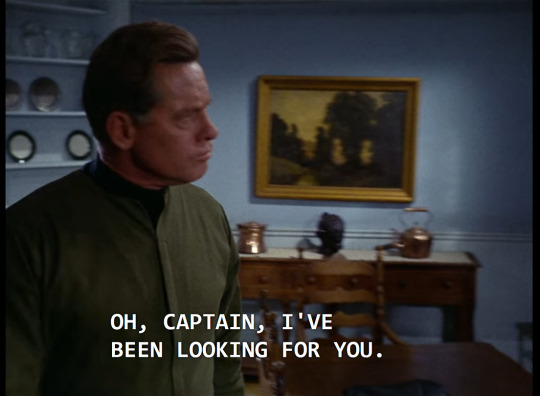
[ID: A shot of the interior of a farmhouse with blue walls, with a large wooden table in the middle of the room, a cabinet with china and glassware in the corner, a wooden desk with a copper tea kettle and some other kitchen items on it against the back wall, and a painting hanging on the wall showing some blurry trees. Sandoval, a middle-aged white man with short brown hair wearing a green jumpsuit, walks past the camera as he says, "Oh, captain, I've been looking for you."]
Kirk asks if McCoy’s found anything yet. McCoy replies that he’s surveyed nine men so far, ranging in age from twenty-three to fifty-nine. And they’re all in perfect condition. Not just healthy—perfect. Textbook responses across the board, from all of them. “If there are many more of them,” McCoy muses, “I can throw away my shingle.”
At that point Kirk’s communicator goes off. It’s Spock, calling in from one of the crop fields. He’s made the same observation as Sulu—there’s no life on the planet aside from the colonists and the plants. No animals, no insects. Spock doesn’t have any explanation yet, so Kirk tells him to carry on with his investigation and hangs up.
McCoy notes the absence of animals as peculiar, and Kirk says it’s especially so because the expedition records show that they did bring animals with them to raise for food. And pull their carts, presumably. But it seems none of them are still around. McCoy says he’d like to see the expedition’s medical records, a request Kirk has apparently anticipated because he’s got the floppy disc on hand with him.
Sandoval comes in and says that he’d like to take the two of them on a tour of the fields, to show off what the colony’s accomplished. McCoy says he’ll have to bow out, since he’s still working on the medical examinations. “However, if I find everyone else’s health to be as perfect as yours...”
“You’ll find no weaklings here,” Sandoval says, which uh, sure is a hell of a way to phrase that. “No weaklings! None of those miserable, pathetic sods with imperfect health! Only the strong survive! THE SLIGHTEST BLEMISH SHALL BE CAUSE FOR EXILE!”
Leaving McCoy behind, Kirk and Sandoval head out to the fields, where Sandoval gushes to Kirk about how great this place is: they’ve got moderate climate, moderate rains all year round, and the soil will grow anything they stick in it. Which is pretty miraculous, considering there’s no such thing as growing conditions that are perfect for every plant. But as we’re about to see, that’s not the only weird thing going on with their farming practices.
The conversation is interrupted by DeSalle arriving to give Kirk the biology report. Sandoval excuses himself to attend to work elsewhere, leaving Kirk and DeSalle alone to discuss the report. At first, it seems to be just as Sandoval said: they’ve got a variety of crops growing here successfully. The weird thing is that they don’t actually have very many of those crops. There’s enough to keep the colony going at the size it currently is, but barely more than that. Which tracks with what we’ve seen of the place so far: a couple of tiny fields that look more about the size for someone’s backyard garden than for a prosperous farm, tended by the occasional person idly scratching at the ground with a hoe. For a supposedly bounteous agricultural colony, that’s pretty weird. What have they been doing all this time?
“It’s like a jigsaw puzzle all one color,” Kirk muses, taking a moment to stroll a few steps away so he can say this dramatically in the distance instead of actually talking to DeSalle. “No key to where the pieces fit in. Why?”
Kirk’s communicator goes off. It’s McCoy, saying Kirk had better get back over there. “Trouble?” “No, but I’d like you to see this for yourself.” Of course. No one can ever just explain something over the phone, can they.
So Kirk heads back to the house, where the thing that Kirk just absolutely has to see for himself turns out to be McCoy just telling him what he’s found out, but he definitely couldn't do that over the communicator for, uh, reasons. What he’s found out is pretty interesting, though: McCoy checked up on Sandoval’s medical records from right before the colonists had left, which said that Sandoval had had an appendectomy, and had scar tissue on his lungs from childhood pneumonia (the weakling!). Yet when McCoy scanned Sandoval himself today, the results came back just as perfect as all the other colonists’. Kirk’s first thought is instrument failure, but McCoy says no, he thought of that and tested it by scanning himself, and it recorded him just fine, down to “those two broken ribs I had once.” Which sounds like an interesting story. But Sandoval’s scan? No scar tissue, and one healthy appendix. That’s right, Sandoval’s apparently managed to regrow an entire organ. Do you think you would notice that happening? Like, would it itch?
While Kirk and McCoy try to figure that out, Spock is hanging out in a field scanning with his own tricorder, while Layla stands nearby smiling ominously at him. Spock muses that there’s “Nothing. Not even insects. Yet your plants grow, and you’ve survived exposure to Bertold rays.” Yeah, how are those plants growing without insects? Presumably the native plants have evolved some way around that, but the ones the colonists have brought from Earth would need some help. Are the colonists just manually pollinating everything? Maybe that’s why they haven’t grown very much.
Layla says this can be explained, but when asked to do so, she just says, “Later.” Spock looks annoyed and remarks, “I have never understood the female capacity to avoid a direct answer to any question.” Hey! Cut that bullshit out. No one on this colony has directly answered a question since you got here, there’s no call to go ragging on a whole gender for it. Besides, just saying “Later,” is hardly a stunningly deft diversion, it’s not like she threw a smoke bomb down and disappeared.
“And I never understood you,” Layla says, walking over and placing a hand on his chest. “Until now. There was always a place in here where no one could come. There was only the face you allow people to see. Only one side you’d allow them to know.”
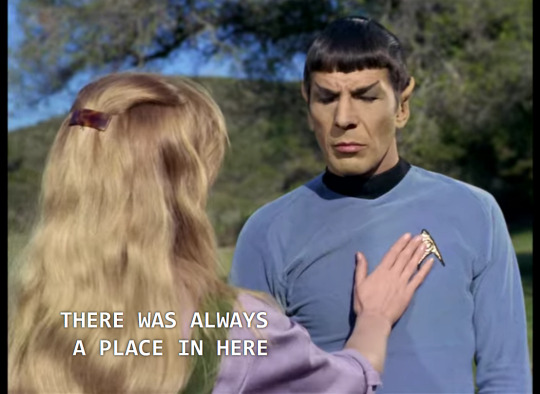
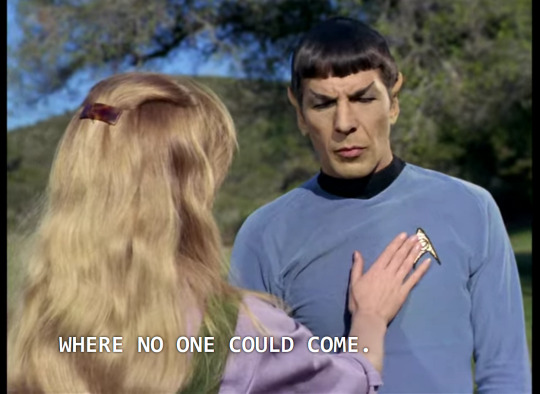
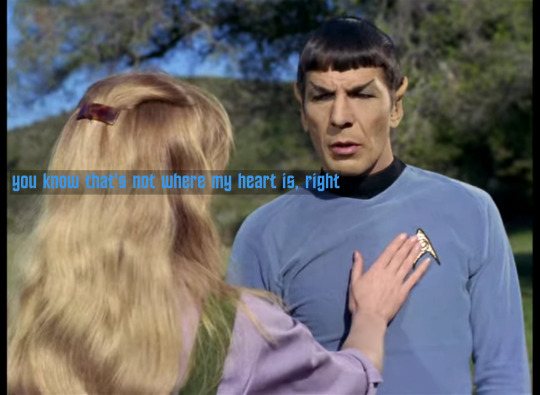
[ID: Three screenshots of Spock and Layla, a white woman with a lot of long blonde hair wearing a lilac shirt and green overalls, standing outside in a field with a large tree in the background. Layla, seen from behind, is pressing her hand to Spock's upper chest and saying, "There was always a place in here where no one could come." Spock replies "you know that's not where my heart is right".]
If Layla was hoping this little speech would prompt Spock to cry out that yes, she’s figured him out, he does love her but has never been able to show it! she’s disappointed, because he just looks uncomfortable and steps away. He tries to steer the conversation back onto the mystery of the colonists. “If I tell you how we survive,” she asks, “will you try to understand how we feel about our life here? About each other?”
That’s a pretty vague thing to make a promise about, so Spock deflects by saying that emotions are alien to him; he’s a SCIENTIST. “Someone else might believe that—your shipmates, your captain—but not me,” Layla says. Oh sure! Obviously none of the people who have lived, worked, and risked death alongside Spock can be expected to know anything about Spock. Only you are the Spock Expert, gifted with incredible insight by virtue of having a crush on him.
“Come,” she says, sauntering off through the field with her hand outstretched to him. Spock rather pointedly folds his hands behind his back instead and follows her.
Back in the house, Kirk and McCoy are struggling to have a conversation with Sandoval. Kirk tells Sandoval that he’s received orders from Starfleet Command to evacuate everyone on the colony, since, y’know, deadly rays and all that. He expects Sandoval to start making preparations. But Sandoval, calmly, casually, says, “No.” It’s not necessary, he insists—they’re in no danger.
But...but the Bertold rays. Sandoval is unmoved, pointing out that as McCoy’s own instruments show, the colonists are in perfect health and there have been no deaths. Okay, what about all those animals? What happened to them? “We’re vegetarians,” Sandoval says blithely. Which, as Kirk points out, does absolutely nothing to answer the question. Actually it raises further questions.
Sandoval remains thoroughly unbothered and thoroughly unhelpful. “Captain, you stress very unimportant matters. We will not leave,” he says, and goes back to gazing out the window, evidently considering the conversation over.
Elsewhere, Spock and Layla are still walking, and Spock is getting annoyed that Layla still hasn’t explained just what it is they’re going to see. “Its basic properties and elements are not important,” Layla says helpfully. “What is important is that it gives life, peace, love.” Oh boy.
Spock is dubious, but Layla pulls him forward, over towards another one of those large pink flowers. “I was one of the first to find them,” Layla says. “The spores.”
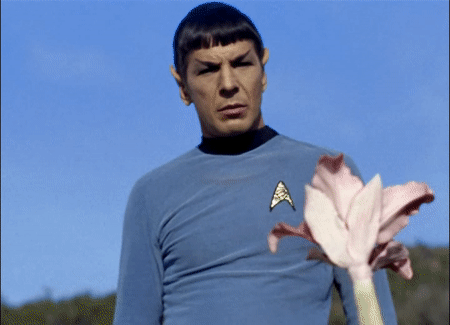
[ID: A gif of Spock approaching a large pinkish-purple flower and saying, "Spores?" The flower then sprays a cloud of white spores all over his face and torso while Spock recoils.]
For a moment Spock just looks startled, but then he starts clutching his head and falling onto his knees in the grass, dropping his tricorder and gasping, “No--” For the first time all episode, Layla’s absolute serenity starts to fracture slightly. Over Spock’s agonized protests, she insists that it shouldn’t hurt—it didn’t hurt any of them. But, as Spock gasps out, he’s not like them. Whoops, did the biologist forget to account for biological differences before handing out a facefull of spores? I bet you didn’t even check if he had any allergies first, did you?
Just as it’s looking like this might put actually put a crack in Layla’s blissed-out impassivity, Spock stops thrashing about and starts seeming less anguished and more confused. Layla’s concern vanishes once again, and she goes back to smiling happily while stroking his face. “Now...now you belong to all of us...and we to you. There’s no need to hide your inner face any longer. We understand.”
Spock still seems unsure, but then he takes Layla’s hand in his and smiles. Not the slight hint of a smile or sardonic quirk of the lips you’d expect to see from Spock, but a huge, broad grin from ear to ear. “I love you...I can love you,” he says, and then he kisses her.
Hoo boy.
After the break, we get a quick Captain’s Log to recap:
“Captain’s Log, supplemental. We have been ordered by Starfleet Command to evacuate the colony on Omicron 3. However, the colony leader, Elias Sandoval, has refused all cooperation and will not listen to any arguments.”
Sure enough, we see Sandoval exiting the farmhouse, followed by McCoy and an extremely frustrated Kirk. “Captain, your arguments are very valid, but do they not apply to us,” Sandoval says, as calm as ever. He tries to walk off, but Kirk grabs his arm and pulls him back.
“My orders are to remove all the colonists,” he says, “and that’s exactly what I intend to do with or without your help.”
“Without, I should think,” Sandoval says, and strolls off, leaving Kirk standing there fuming.
Sulu and Kelowitz come walking up to report that they’ve checked out everything and it all seems normal, except for the missing animals. Of course, they also both said they had no idea what to look for in the first place, so maybe take that with a grain of salt. Kirk tells them about the evacuation orders, and says he wants landing parties to start gathering the colonists and preparing them to leave. And by the way, where did Spock and DeSalle go? Sulu says they haven’t seen either one in some time, but McCoy says DeSalle was going to examine some native plants he found. Native plants, huh? I think we can guess what happened to DeSalle.
Since Spock still hasn’t reported in, Kirk gives him a call. Or tries to, at least—Spock doesn’t pick up. On the other end of the line, we see why that is: Spock's communicator is laying abandoned on the ground, while Spock himself, now dressed in the same horrible green jumpsuit as the colonists, is stretched out on the grass with Layla, watching clouds. The communicator beeps away while Spock happily describes how one of the clouds looks like a dragon. "I've never seen a dragon," Layla says. BEEP BEEP. "I have." BEEP BEEP. "On Barengarius 7." BEEP BEEP. "But I've never stopped to look at clouds before." BEEP BEEP. "Or rainbows." BEEP BEEP. "You know, I can tell you exactly why one appears in the sky, but considering its beauty has always been out of the question." BEEP BEEP.
"Not here," Layla says (beep beep), and they smile dreamily at each other before going into another makeout session. Meanwhile, Kirk is still on the line, and not getting any happier about it. Layla finally picks up the communicator and holds it up for Spock, who takes a break from kissin' to say, "Yes, what did you want?"
Naturally, this throws both Kirk and McCoy for a loop. While McCoy stands there with a "what the fuck" look on his face, Kirk takes a moment to recover and then demands, "Spock, is that you?"
"Yes, captain, what did you want?"
"Where are you?"
"...I don't believe I want to tell you."
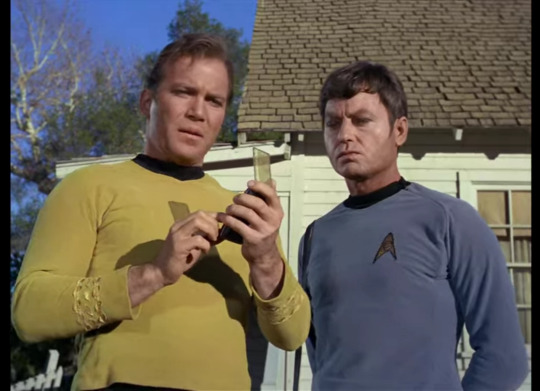
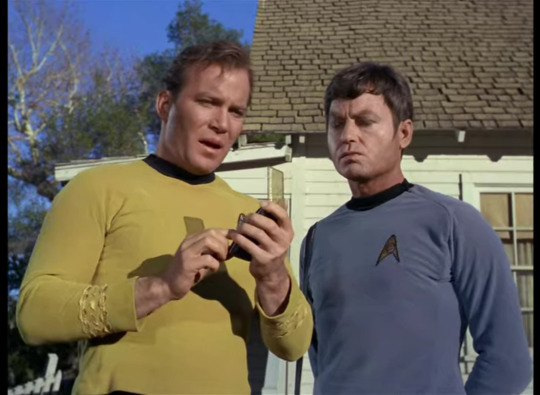
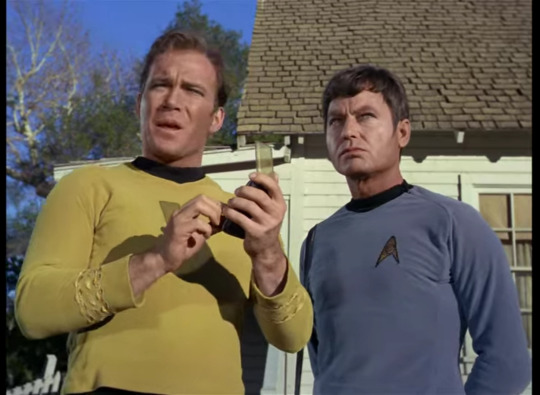
[ID: Three shots of Kirk and McCoy standing in front of the farmhouse, Kirk holding his communicator while McCoy looks on. Kirk has a stunned expression on his face and looks around with his mouth open, trying to figure out what to say.]
Kirk plows on ahead, telling Spock that, whatever the hell he thinks he's doing, he's got orders: they're getting the colonists out, and Spock is to meet back at the settlement in ten minutes.
"No, I don't think so," Spock says casually. "You don't think so, what?" "I don't think so, sir."
Kirk has to take a moment after that one. It's rather amazing that McCoy's made it this far into the conversation without saying anything himself. Presumably he's just in shock. Eventually Kirk tells Spock to report in immediately, but by now Spock and Layla have gone back to kissing, leaving the communicator open but abandoned in the grass once more.
"That didn't sound at all like Spock, Jim," McCoy says, putting in his bid for the Enterprise’s bi-weekly Massive Understatement contest.
"No, it--I thought you said you might like him if he mellowed a little."
"I didn't say that!"
"You said that."
"Not exactly,” McCoy protests, and then somewhat grudgingly adds, “He might be in trouble.”
I'm sure McCoy did say that, or something like it, but "I hope Spock has his brain taken over by alien spores" was presumably not where he was going with it. He obviously sees this sudden change of behavior as something to be concerned about--even moreso than Kirk, who seems more irritated than anything. But then, it's only been a couple episodes since McCoy had his own run-in with an alien influence making people act a lot more mellow than usual, and he didn't enjoy that experience at all, so it's not surprising that "trouble" is his first thought here.
Kirk tells McCoy to take over the landing party detail and start getting the colonists up to the ship, and to make sure the party works in teams of two, with nobody being left alone. Meanwhile, Kirk himself takes Sulu and Kelowitz and heads off to find Spock, using the open frequency from Spock's communicator as a homing signal. They follow a dirt path out of the main settlement and soon find said communicator, laying open and abandoned in the grass just off the path. As Kirk picks it up, they hear laughter nearby, and Sulu points in astonishment further down the path, where Layla is watching Spock dangle upside-down from a tree branch like a kid on a jungle gym.
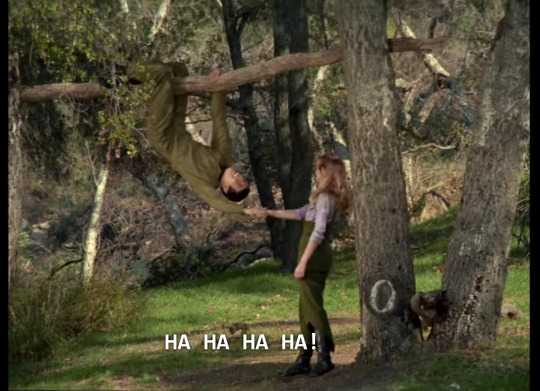
[ID: A shot of Spock and Layla among some trees at the end of a dirt path. Layla is standing on the ground and holding hands with Spock, who is hanging upside-down by his knees from a large tree branch, laughing.]
For a moment all Kirk can do is stare weakly at this weird spectacle. Then he collects himself with a stern AHEM and marches over like a principal about to deliver some very serious detention.
Meanwhile, back at the main hub of the colony, the landing party seems to have gotten well underway with preparations for departure, with several colonists and crewmen piling up luggage and equipment in the middle of a field while McCoy stands nearby overseeing everything, a job I’m sure he’s enjoying since we all know administrative work is McCoy’s favorite thing. Then DeSalle arrives, carrying a couple of the spore flowers and tells McCoy to take “a good, close look” at them, because they’re very interesting. McCoy steps forward to check them out right before the scene cuts away again, leaving us with little doubt as to what’s about to happen next.
During that little interim, Kirk and his crew have made it over to where Spock and Layla are cavorting. Spock just grins happily at Kirk, clearly not bothered one bit, even as Kirk asks if Spock’s out of his mind. He didn’t report to Kirk, he says, because...he didn’t want to.
Kirk glances back and forth between Spock and Layla, who’s standing there smiling rather smugly, and tells Layla that she’ll need to come get ready to evacuate with the rest of the colonists. Spock cheerfully says that there’s not going to be any evacuation. “But perhaps,” he adds, “we should go and get you straightened out.”
That really doesn’t bode well, but rather than ask just what Spock means by that, Kirk tells Sulu that Spock is under arrest in Sulu’s custody until they get back to the ship. Which will certainly work out well because it’s not like Spock is strong enough to chuck Sulu all the way across the field barehanded or anything. Not that Spock seems especially perturbed about being under arrest; instead he just shrugs, drops down from the tree, and says, “Very well. Come with me,” before heading off across the field, leaving else to follow in confusion. That’s how you arrest someone, right?
Of course, Spock leads them right to another group of spore flowers, which the group stops and stares at obligingly for a moment. Then the flowers explode a bunch of spores at them. Somehow, even though he’s standing right next to Sulu and Kelowitz, Kirk manages to totally avoid getting any spores up his sinuses, while the other two are immediately affected. “Yes...I see now,” Sulu says blissfully, with that trademark Very High grin that George Takei does so well. “Of course we can’t remove the colony. It’d be wrong.”
Kirk grabs him by the shoulders—Kirk’s go-to method for snapping people out of it--but when this somehow fails to bring Sulu back to his right mind, all Kirk can do is say that he doesn’t know what these plants are or how they work, but “you’re all going back to the settlement with me, and those colonists are going aboard the ship.” This stern proclamation has absolutely no effect on anyone. The whole group just stands there happily watching Kirk stomp back toward the colony. “I can see the captain is going to be difficult,” Spock remarks.
Kirk’s day isn’t about to get any better, because upon making it back to the colony he’s greeted by McCoy, who we can immediately tell is under the influence as well because his accent is absolutely out of control. It’s so thick even the subtitles pick up on it.
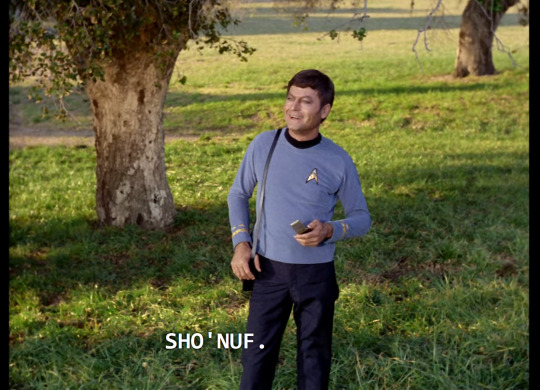
[ID: A screenshot of McCoy walking through a meadow with his communicator out, saying, "Sho’nuf."]
“Hiya, Jimmy boy!” McCoy very happily says to a very unhappy Kirk. “Hey, I’ve taken care of everything. Now all y’all gotta do is just relax. Doctor’s orders!” With a very resigned look, Kirk asks how many plants McCoy’s beamed up to the ship, and McCoy says it must be going on a hundred by now.
So Kirk beams up to the ship and heads right to the bridge, where he tells Uhura to put him through to Admiral Komak at Starfleet, though what he expects Komak to do about all this I don't know. But it’s too late. Uhura turns around to show that she’s smiling as happily as everyone else, and says, “Oh, I’m sorry Dave, I mean, captain. I can’t do that.” She’s short-circuited all the ship’s communications, except for ship-to-surface, since they’ll need that for a little while yet. Then she leaves, pausing in the door of the lift to tell Kirk that it’s really all for the best.
Kirk stands there seething for a moment, then stomps over to grab a plant that’s been left in Spock’s chair. He throws it across the bridge, and the camera lingers ominously on it as Kirk heads back into the lift.
Things aren’t any better on the rest of the ship. Kirk soon finds a long line of crewmembers of all different shirt colors, patiently waiting to transport down to join the colony. Out of what I can only assume is some desperate futile hope that someone will follow his orders if he just keeps trying, Kirk orders them all to go back to their stations at once. Unsurprisingly, they all ignore him. Kirk points out to one of the redshirts that this is MUTINY! but it doesn't get him very far.
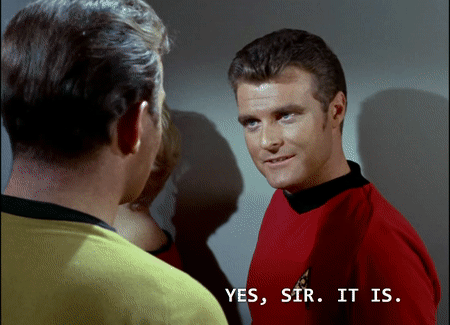
[ID: A gif showing a young white man with brown hair wearing a redshirt as he says, "Yes, sir, it is." The camera then zooms in very dramatically on Kirk's stunned face.]
So...they’re all going down to join the colony? All four hundred thirty of them? Or four hundred twenty-nine, I guess, if Kirk refuses to join the fun. That’s almost ten times the amount of people the colony currently has in it. That seems like it could present a bit of a problem, because if you’ll recall DeSalle told Kirk earlier that right now the colony’s growing enough food to feed their current population, with little left over. How are they going to handle such a large and sudden influx into their population? Do they have housing for all these people? Or are they just all going to eat dirt and sleep on the ground because they’re all too high to notice anyway?
After we’ve had a commercial break to contemplate this shocking turn of events, Kirk takes some time out to give vent to his feelings in a captain’s log:
"Captain's Log, Stardate 3417.5. The pod plants have spread spores throughout the ship, carried by the ventilation system. Under their influence, my crew is deserting to join the Omicron colony, and I can't stop them. I don't know why I have not been infected, nor can I get Doctor McCoy to explain the physical, psychological aspects of the infection."
And indeed, just in case we had any doubt, we then see McCoy strolling through the field and happily telling Kirk, “I’m not interested in any physical, psychological aspects, Jim-boy. We all perfectly healthy down here.” Kirk grumbles about how much he’s been hearing about things being perfect lately. “I bet you’ve even grown your tonsils back.” “Sho’nuf!”
Kirk tries desperately to get McCoy to do something to figure these spores out—run a blood test, take a scan, type the symptoms into WebMD, something, anything—but McCoy is more interested in rambling on about mint juleps. Meanwhile, back in the farmhouse, Sandoval’s having tea with Spock while they talk about how nearly everyone’s beamed down from the ship and things are “proceeding quite well.” Kirk storms in and demands to know where McCoy’s gotten to, and Spock says he went off to make that mint julep. Which could prove quite difficult unless this tiny half-assed farm colony has somehow managed to set up a working distillery around here somewhere, but Kirk’s got bigger concerns right now than where McCoy’s going to get his bourbon.
Sandoval wants to know why Kirk won’t join them in their private, spore-sponsored paradise. Kirk asks where these spores came from, anyway, and Spock exposits that there’s no way to know—they just drifted through space until they arrived at this planet, which is perfect for them because it turns out they actually thrive on Bertold rays. The plants act as a repository for the spores until they can find a human—or half-Vulcan—body to inhabit. No explanation is forthcoming as to how Spock knows any of this.
Spock and Sandoval insist that the planet is “a true Eden” with belonging and love and no needs or wants for anyone, but Kirk is skeptical. “No wants, no needs. We weren’t meant for that. None of us. Man stagnates if he has no ambition, no desire to be more than he is.” Of all the things wrong with this situation I’m not sure “BEING TOO HAPPY IS BAD FOR YOU” is the take I would go with, but okay. Spock says that Kirk doesn’t understand, but he’ll come around...sooner or later.
Kirk, disgusted with this whole conversation, goes back to the ship. The bridge is dark, silent, and utterly empty. We get a slow pan of the blinking lights and displays of the consoles, with no one left to man them. Kirk walks over to his chair, hits the intercom, and starts calling one part of the ship after another, with no response from any of them. With nothing else left to do, he sits down in his chair and starts glumly recording a captain’s log so angsty it could be a LiveJournal entry:
"Captain's Log, Stardate 3417.7. Except for myself, all crew personnel have transported to the surface of the planet. Mutinied. Lieutenant Uhura has effectively sabotaged the communications station. I can only contact the surface of the planet. The ship...can be maintained in orbit for several months, but even with automatic controls, I cannot pilot her alone. In effect, I am marooned here. I'm beginning to realize...just how big this ship really is, how quiet. I don't know how to get my crew back, how to counteract the effect of the spores. I don't know what I can offer against...paradise."
Hold on hold on HOLD ON what do you MEAN the ship can be maintained in orbit for several months? Every time someone takes their hands off the controls for five seconds we get told that the orbit is decaying and they’re gonna plummet into some hapless planet within a few hours at most but now all of a sudden it’s fine to hang out up there for several months? MAKE UP YOUR MIND.
Kirk gets up to go sit at the helm, just to get a change of scenery mid-mope, and as he finishes his log/rant the camera slowly pans down to reveal the spore flower that he chucked across the bridge earlier. Which is weird because we just got a wide shot of the bridge and that flower definitely wasn’t there then.
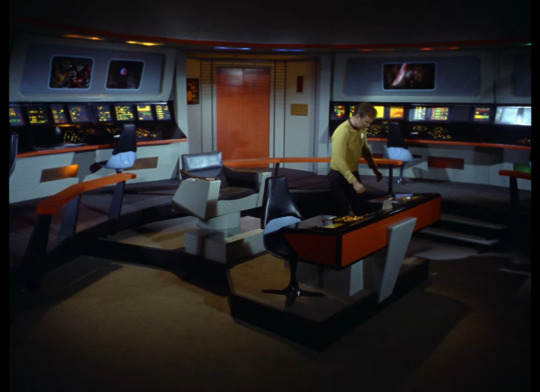
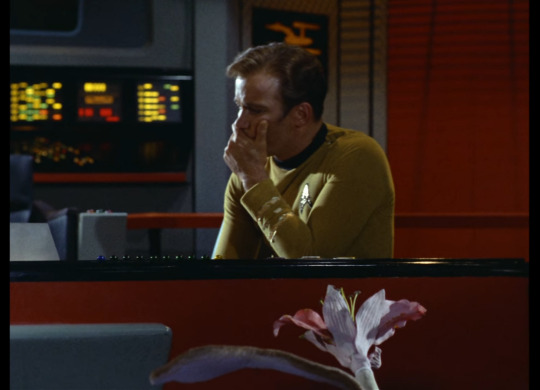
[ID: Two shots. The first is a wide shot showing Kirk alone on the empty, darkened bridge, preparing to sit down at the helm. There is nothing in on the floor in front of the helm. The second shot is a closer shot of Kirk sitting at the helm with his chin in one hand, now with a large spore flower poking up in the front of shot.]
The flower promptly shoots Kirk in the face, and for a moment he just continues to sit there with spores in his hair and a “yeah, this might as well happen” expression. But then he slowly starts to smile, suddenly as happy as everyone else. Exactly why Kirk’s been unaffected by the spores up until now, even after hanging out for quite a while on a ship that’s supposedly been thoroughly contaminated by them, is never really explained. Maybe he's just on a lot of Zyrtec. But it seems even Kirk’s determination to not be happy can’t hold out against a point-blank spray in the face. He calls Spock to say that he finally understands now, which Spock is happy to hear. Kirk says he’ll be down just as soon as he packs up a few things, so Spock says he and Layla will wait for him at the beamdown point.
So Kirk goes off to his quarters to pack up a suitcase, the contents of which seem to mostly consist of uniform shirts. Apparently paradise for Kirk does not include one of those green jumpsuits, which, really, who can blame him. He opens a small vault by his bed and pulls out a couple of black cases, one of which he opens to reveal a medal. This seems to stir some sense of conflict because he sits down and stares at it for a long moment, but then puts it aside and heads to the transporter room, where he puts the suitcase on the platform and then prepares to set the controls.
But then Kirk hesitates, and stands there for a moment looking conflicted. Possibly he’s still having feelings about those medals, or maybe he’s having second thoughts about whether he packed enough shirts. In any case, he eventually exclaims, “No...No! I...can’t...LEAVE!” Then he punches the console for good measure.
Apparently this little emotional outburst is all it takes to cure the spores, because Kirk gasps a little, looks momentarily confused, and then seems to be back to his old self. “Emotions...violent emotions. Needs...anger,” he tells the empty room. “Captain’s log, supplemental. I think I’ve discovered the answer...but to carry out my plan entails considerable risk. Mr. Spock is much stronger than the ordinary human being.” Then he treats us to this remarkable line:
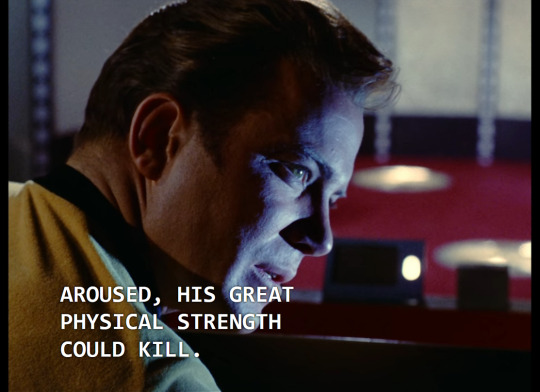
[ID: A shot of Kirk in profile at the transporter controls as he says, "Aroused, his great physical strength could kill."]
um
Down on the planet, Spock and Layla are still waiting at the beamdown point when Kirk calls Spock up and says he’s realized there’s some equipment on the ship that they’ll need for the colony, and he needs Spock’s help to get it all beamed down. Really, you’d think there’d be quite a lot of equipment on the Enterprise that a farming colony could make good use of, but I guess they’re really determined to stick to the whole no-technology approach. Despite this, Spock cheerfully accepts the explanation, gives Layla a quick smooch, and beams up.
But upon materializing, Spock is greeted not with a smiling Kirk ready to go move some equipment with his bro, but Kirk standing there holding some nonspecific heavy metal rod thing that he’s smacking threatening against his hand. “All right, you mutinous, disloyal, computerized half-breed,” he says, “we’ll see about you deserting my ship.”
Spock reacts to this bar-brawl-starter with nothing more than a nonplussed expression and polite correcting Kirk on his syntax. Kirk, determination unshaken, continues laying into him with a stream of insults that would have made that fucker from Balance of Terror go, “Whoa, hold on there a minute.” Undeterred by not being able to use any actual expletives, he compares Spock both to a machine and to various fairy-tale creatures, makes fun of his ears, and rounds it all off by having a go at the entire Vulcan race. He even insults Spock’s parents.
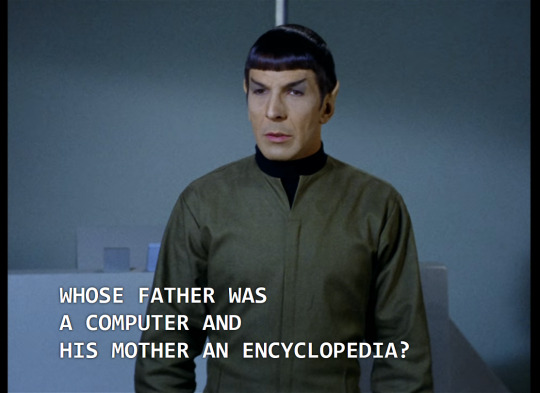
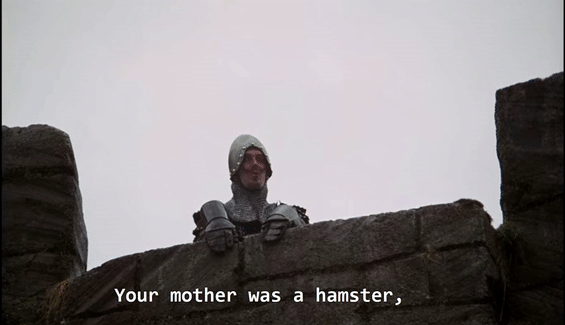
[ID: 1. A shot of Spock standing in the transporter room looking perplexed as Kirk, off-camera, says, "Whose father was a computer and his mother an encyclopedia?" 2. A gif from Monty Python and the Holy Grail of John Cleese as the French knight on the battlements yelling, "Your mother was a hamster and your father smelt of elderberries!"]
Spock stands there taking it all stoically for quite a while, even as the background music gets increasingly tense. He finally starts to crack when Kirk goes after Spock’s relationship with Layla, and when Kirk keeps going despite Spock angrily telling him, “That’s enough,” Spock finally flips out big time. You know what that means, it’s time for a STAR TREK FIGHT SCENE! This one’s got it all: close-up shots of the actors intercut with long shots of very obvious stunt doubles; cardboard props getting punched; even people picking up random unidentifiable bits of starship equipment that may or may not have ever been there before to use as weapons. The only thing we’re missing is Kirk doing some kind of weird wrestling move.
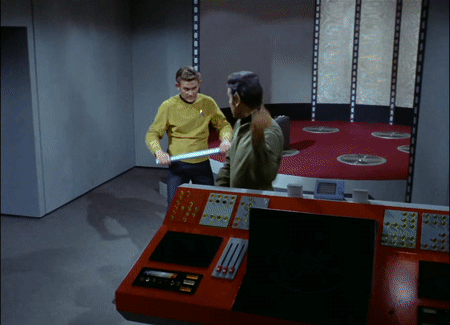
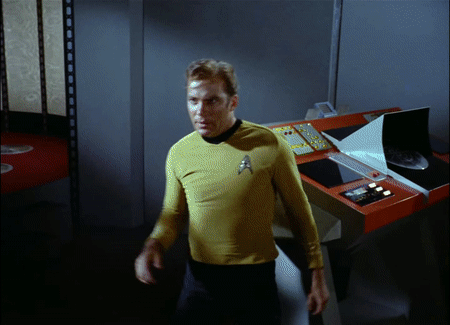
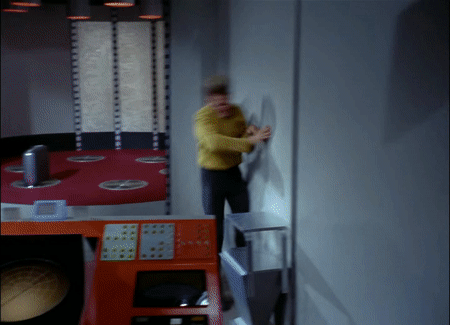
[ID: Three gifs showing a fight scene between Kirk and Spock. First we see a long shot where Kirk and Spock are clearly being played by stunt doubles, as Spock punches a metal rod Kirk is holding, bending it in half. He then punches Kirk in the jaw, sending him careening into the wall. Then a close-up of Nimoy and Shatner as Spock advances on Kirk and throws a punch but misses, denting the control panel in the wall behind Kirk. Kirk dodges out of the way towards the console, and Spock throws another punch that hits the side of the console. Then back to a long view with the stunt doubles as Spock throws Kirk into the opposite wall, which Kirk careens off of, falling on his back on the floor, while Spock picks up something resembling a square metal stool or stepladder and raises it over his head. Finally, we see Nimoy and Shatner again as Kirk lays on the floor looking up at Spock, raising the thing he's carrying over his head.]
We dramatically cut to black as Spock stands poised above Kirk, raising whatever-the-hell-that-thing-is over his head threateningly. Apparently the ad break gives him enough time to cool down, though, because instead of bringing the thing down on Kirk’s skull, he hesitates.
“Had enough?” Kirk asks. “I didn’t realize what it took to get under that thick hide of yours.”
Spock slowly lowers the thing, looking a bit regretful about having to do so. Kirk says he doesn’t know what Spock’s so mad about, anyway. “It isn’t every first officer who gets to belt his captain...several times.” Dude, you just stood there and unleashed a screed of personal and racial insults at your best friend here. A “sorry” probably wouldn’t go amiss here.
“You did that to me deliberately,” Spock realizes, and then realizes that the spores are gone. “I don’t belong anymore.” Kirk explains that since the spores are “benevolent and peaceful,” violent emotions overwhelm and destroy them—that’s the answer. Which...definitely makes sense, chemically speaking. Sure.
Spock, still looking pretty glum about all this, points out that Kirk’s method might have worked out alright for curing one person, but they’ve got over five hundred infected people down there, and trying to pick a fight with all of them probably isn’t going to go so well. But no worries, Kirk’s got another plan. He wants Spock to rig up a subsonic transmitter that they can hook up to the ship’s communications system and then broadcast to all the communicators. Spock says he can do that, but hesitates as Kirk turns to leave. “Captain. Striking a fellow officer is a court martial offense,” he points out.
Kirk mulls over that one for a moment. “We-ll...if we’re both in the brig, who’s gonna build the subsonic transmitter?” he says, and Spock concedes the point. Besides, it’s a bit late to be worrying about striking fellow officers now.
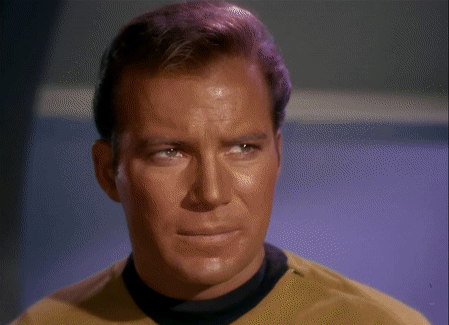
[ID: A gif from The Naked Time of Kirk and Spock standing in an Enterprise conference room. Kirk slaps Spock across the face, and Spock retaliates by backhanding Kirk so hard he is thrown across the table in the center of the room and falls onto the floor on the other side.]
But what with the insults and the punching and de-sporing and everything, it seems that something has clean slipped Spock’s mind: Layla’s still down there waiting for him to come back. As she stands around the field, McCoy wanders over and asks what’s up. When she tells him that she’s been out here for some time now waiting for Spock and Kirk to come back, he gentlemanly offers to fix that for her and calls the ship. Spock picks up, and Layla asks if everything’s okay up there.
With obvious discomfort, Spock tells her that yes, he’s...quite well. Layla, oblivious to anything being wrong, asks if she can come up there, because she wants to talk to him, and besides, “I’ve never seen a starship before.” Wait a minute, never seen a starship before? You’re on a planetary colony! What, did you drive here?
Spock asks if she’s still at the beamdown point, and if McCoy’s there. Layla says yes to both, so Spock tells her to give the communicator back to McCoy, since she won’t need it to transport, and he’ll have her beamed up in a few minutes. One might think that at this point they might take this easy opportunity to also beam up McCoy and get him cured (it shouldn’t be hard, McCoy is already 85% comprised of negative emotions to begin with), so he can start investigating these spores, just in case Operation Go For the Eardrums doesn’t work. But they don’t. Kirk awkwardly asks Spock if he’s sure about talking to Layla while she’s still spore’d, but Spock just nods and heads to the transporter room.
He beams Layla up, and she happily runs over to give him a hug—they’ve been parted ever so long, after all—but when he just stands there stiffly, not reacting at all, she slowly pulls back and says, “You’re no longer with us, are you?”
Spock says it was necessary. Layla begs him to come back to the planet and belong again, but he says he can’t. She starts crying and saying she loves him. "I said that six years ago, and I can't seem to stop repeating myself. On Earth, you couldn't give anything of yourself. You couldn't even put your arms around me. We couldn't have anything together there. We couldn't have anything together anyplace else. But we're happy here. I can't lose you now, Mr. Spock, I can't." Look, if the only time the relationship you want can possibly work out is when the other person is being mind-controlled by alien spores, I think it may be time to consider whether this is really a relationship you should be pursuing in the first place.
“I have a responsibility to this ship...to that man on the bridge,” Spock gently tells her. “I am what I am, Layla. And if there are self-made purgatories, then we all have to live in them. Mine can be no worse than someone else’s.”
Layla soon realizes that all this anguish has resulted in her getting de-spore’d as well, and she’s not happy about it. “And this is for my own good?” she demands angrily. Well...yes, I mean, it is, but Spock doesn’t say that. Nor does he respond when she asks, “Do you mind if I say I still love you?” but she hugs him again anyway.
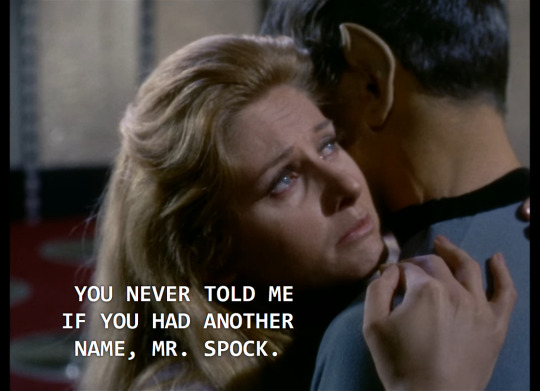
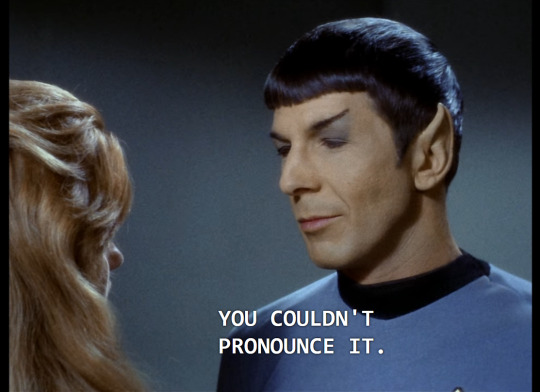
[ID: Layla tearfully embraces Spock and says, "You never told me if you had another name, Mr. Spock." Spock replies, "You couldn't pronounce it."]
ROMANCE
We’re obviously supposed to read this little story arc as the tragic tale of true love destined never to be, because Spock is only able to express his feelings for Layla under the influence of the spores. He has experienced paradise, but alas, he cannot linger there, and so on. It’s never set all that well with me, though. The problem is we never really get Spock’s side of the story and so it leaves open the question of how much he actually did want this relationship in the first place. Layla said earlier that “Mr. Spock’s feelings were never expressed to me” so evidently he never outright said “I love you but I can’t be with you” or anything of that sort to her. When they’re alone in the field before Spock gets spore’d he seems stiff, standoffish, awkward, and deflects all of her overtures with what appears to be discomfort, even annoyance. He clearly has no interest in talking about whatever history they had together, even when they’re all alone. For all that Layla goes on about how she can see a side of Spock that his crewmates don’t, we see interactions with those crewmates multiple times throughout the show that prove that Spock is perfectly capable of showing people that he cares about them, even if the ways he does it are usually a bit atypical. We don’t see any of that in his initial interactions with Layla.
If we accept the premise that the spores only make people act as they would if they had no inhibitions or fears holding them back, then yes, Spock saying he loves Layla after he’s been spore’d would indicate that he did secretly love her all along. The problem is that we know the spores make people do things that they would not ordinarily want to do. You think all of those four hundred thirty people on the Enterprise secretly longed for a quiet life among the soil but all chose to instead join the space navy for some reason? Should we believe Scotty is actually deep down perfectly okay with abandoning his beloved ship to a slowly decaying orbit? I doubt that Kirk has always harbored a subconscious desire to give up exploring the final frontier to pursue a peaceful agrarian lifestyle, but he very nearly does do just that. So the question of how much a relationship with Layla is what Spock “really” wanted seems to be a bit hazy.
Mind, I’m not saying this makes Layla an evil person who deliberately drugged Spock so she could have a relationship with him or anything like that. It’s clear throughout the episode that the spores induce those who are infected by them to spread them around to anyone nearby who’s not in the spore fandom yet, so there’s no reason to believe Layla would act as she did if she wasn’t under the influence herself. I just personally find it hard to buy into the tragic romance of a star-crossed relationship when the thing crossing the stars is that one of the participants is only enthusiastic about the whole thing when they’re not fully sober. It makes me question how much of their previous relationship really was Spock having feelings for Layla but being unable to express them, versus Layla projecting a lot of feelings onto him and writing off his disinterest or discomfort as denial.
Kirk and Spock go back to working on the signal, while Layla deals with her heartbreak by disappearing into thin air for the rest of the episode. Spock says that the sound they’re going to send out is on a frequency that won’t be heard so much as felt, but apparently it will be felt quite emphatically. Kirk compares it to putting itching powder on someone. Which may seem like another silly technobabble deus ex machina, but speaking from personal experience, driving someone into a frantic frustrated fit by playing an obnoxious noise just on the edge of hearing sounds totally legit. All they need to complete the sensory overload meltdown experience is find a way to simulate some flickering florescent lights and put tags on the backs of the uniform shirts.
And indeed, as the device starts to work, we see Sulu and DeSalle working in one of the fields—for a certain value of ‘working,’ anyway, they’re kind of just digging around aimlessly—when Sulu accidentally elbows DeSalle in the back. He apologizes, but DeSalle shoves him back, and before long they’re having a full-on brawl right there in the field, which can't be good for the crops. As the device on the ship hums away, two more crewmembers start their own fight over by the farmhouse, and when a third tries to break them up he promptly gets dragged into it as well.
The effects haven’t quite reached everyone just yet, though, as we see McCoy chillaxing under a tree with some unspecified concoction. Sandoval strolls up and says that he’s been thinking about what sort of work he could assign McCoy to. When McCoy protests that he does one kind of work and that’s doctorin’, Sandoval says that he’s not a doctor anymore—they don’t need any doctors here.
This does not go over well.
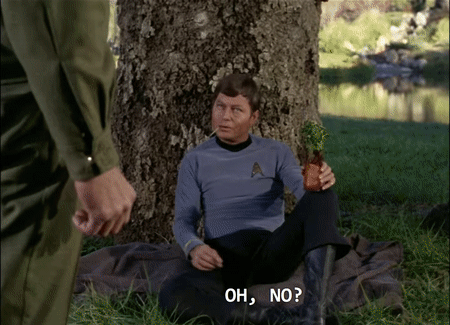
[ID: A gif showing McCoy reclining against a tree in a grassy meadow, a stalk of grass in one hand and a grass of something brown with several leafy stalks in it. Sandoval is standing over him. McCoy says, "Oh, no?" and then slowly stands up, tosses his grass stalk aside, looks Sandoval in the eye and says, "Would you like to see just how fast I can put you in a hospital?"]
Undeterred, Sandoval says that he’s the leader and he’ll be assigning McCoy whatever work he wants to, but when he tries to walk away McCoy pulls him back and snarls, “You’d better make me a mechanic. Then I can treat little tin gods like you.” Sandoval throws a punch at him, but McCoy dodges and whacks Sandoval in the stomach, putting him out flat on the ground. See, I told you it wouldn’t be hard to cure McCoy. Everyone else on the Enterprise was perfectly happy to give up their careers to go do a bit of light farming, but tell McCoy he can’t be a doctor anymore and no amount of spores are going to save you.
While Sandoval is busy rolling around on the ground, McCoy stands there looking confused for a moment, then—presumably having only just now noticed that instead of a mint julep he’s actually been drinking a coke with a bunch of cilantro in it—throws his drink aside and admits that he’s not sure why he just clobbered Sandoval. But Sandoval has other concerns for the moment. With a look of dawning horror familiar to all us chronic procrastinators, he abruptly realizes that they haven’t actually been doing anything all this time. “No accomplishments, no progress. Three years wasted. We wanted to make this planet a garden...”
McCoy points out that the colonists really will have to leave—they can’t survive here without the spores handling all that radiation for them. But the dream’s not over; the colonists could be relocated to start again somewhere a bit less deadly, if that’s what they want.
“I think I’d...I think we’d like to get some work done,” Sandoval muses. “The work we set out to do.”
McCoy calls Spock and says that Sandoval wants to talk to Kirk. Spock notes to Kirk that the crew are all starting to rather sheepishly call in by now. Sandoval tells Kirk that the colonists will fully cooperate with the evacuation now, and Kirk tells him to start making the preparations. Real ones, this time.
Sometime later, everyone’s back on the bridge getting ready to head out. McCoy reports that he’s examined all the colonists and they all remain in perfect health. “A fringe benefit left over by the spores.”
One would think that this would have been quite the eventful afternoon for the medical sciences, given that they just discovered spores with such incredible healing powers that they can make people regrow organs, and McCoy just confirmed that anything healed by the spores stays healed after the spores are gone. Sure, they’ve got some side effects, but Kirk’s already discovered a simple way to get rid of the things once they’re no longer needed. Strap someone to a bed, give em a facemask full of spores, let them lay there for a while having a nice buzz while they heal their cancer or whatever, then play an irritating noise at them until they sneeze the spores back out again. Boom. Done. You’ve solved medicine. Or, y’know, we could vacate the planet and never speak of it ever again, that works too.
Notably unmentioned by anybody during this little denouement is the fate of the other two settlements on the planet that Sandoval mentioned back near the beginning of the episode. The length of the timeskip isn’t specified, so it’s possible that the crew went and collected them as well in the interim, but we never get any details as to how that little adventure went, assuming that it did happen and that the Enterprise isn’t about to get halfway to the next starbase before Kirk realizes he forgot something.
As they watch the planet diminish behind them on the viewscreen, McCoy muses that this was “the second time man’s been thrown out of paradise.” Kirk disagrees. "No, no, Bones, this time we walked out on our own. Maybe we weren't meant for paradise. Maybe we were meant to fight our way through--struggle, claw our way up, scratch for every inch of the way. Maybe we can't stroll to the music of the lute. We must march to the sound of drums."
Spock remains unimpressed by this bit of philosophizing. “Poetry, Captain. Nonregulation.” Kirk notes that they haven’t heard anything from Spock about this whole ordeal, since, y’know, that definitely seems like something Spock would want to talk about. He says he’s got little to say about Omicron Ceti 3.
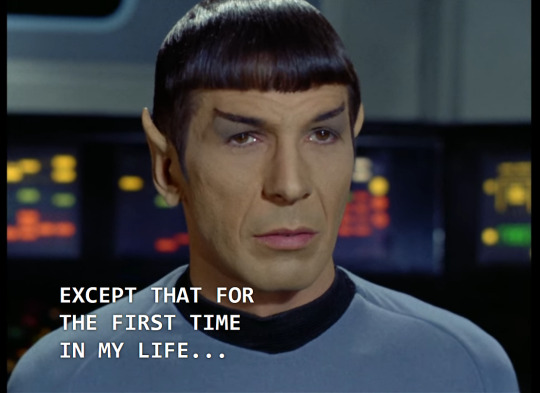
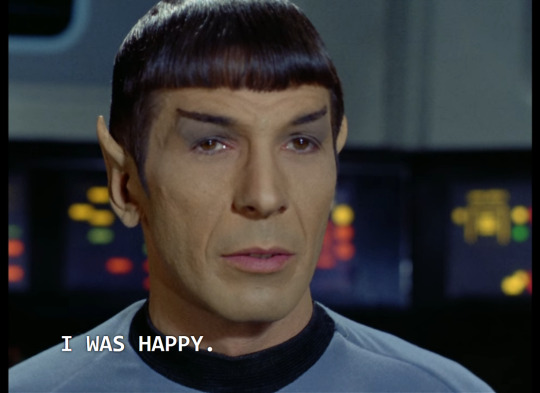
[ID: A close-up of Spock on the bridge as he says, "Except that for the first time in my life...I was happy."]
oh my god someone needs therapy
On that INCREDIBLY CHEERFUL note, the Enterprise flies away and the episode ends.
It’s somewhat baffling to me that of all the quite reasonable objections available to the whole situation with the spores, the main problem that Kirk—and by extension, the episode—seems to have is that “the spores make things too EASY and mankind was meant to STRUGGLE!!!” I mean, effectively what we had going on here was people being drugged without their consent into a state that overwrote their own desires, ambitions, emotions and much of their individual personalities and replaced them with bland, happy conformity to a goal and lifestyle none of them actually chose. That seems a bit worse to me than “people weren’t working hard enough.” Kirk goes on and on about how the spores made things too easy, but what they really did was make people apathetic to whether they succeeded at anything or not. Sandoval’s horrified when he’s cured of the spores because the colonists had much different plans for their colony; far from making those plans easier, the spores made them impossible. The dreams and desires of the Enterprise crew for a life of exploration among the stars would have been forever unmet if they had permanently joined the colony, they just wouldn’t have been able to care. Kirk seems to believe that the ultimate evil of the spores is that they deprive people of ambition; to me it seems that the worse evil is that they deprive people of their individuality and their autonomy.
Then there’s the fact that while the spores make people happy and friendly, they also make them remarkably blasé about the well-being of anyone who isn’t part of their collective. They have to be—caring about whether someone else is upset or hurt would make them unhappy, after all. Spock and McCoy are completely unconcerned with the mounting distress of their best friend, and beyond peer pressuring him to get with the program and take the spores like everyone else, they don’t seem to much care if he remains the only unhappy person on the planet. The colonists seem completely unbothered by the fact that all the animals they brought with them died a rather grueling death by radiation poisoning. Everyone on the Enterprise is happy to abandon the ship and join the colony with no message left behind for Starfleet, with apparently not a thought to spare for any friends and family back home, who would only ever know that their loved ones disappeared into space never to be seen again.
Or at least, they would if things actually went according to plan, which they probably wouldn’t, because the spores also made everyone cheerfully oblivious to the idea that anything could potentially cause a problem or pose a threat to them. After all, if Kirk hadn’t had a recovery at the last minute, the Enterprise would have been left unmanned in orbit around the planet, with no way for anyone in the colony to get back onboard. Uhura also goes out of her way to make sure that they no longer have any off-planet communication. So it’s probably not going to be long before Starfleet notices that one of their prize starships has abruptly gone incommunicado, and I’m willing to bet they’d be a bit quicker on that investigation than they were about checking on a tiny backwater colony (although it is Starfleet, so who knows, really). And since they know exactly where the ship was headed on its last recorded mission, it probably won’t take them long to find it. If Starfleet sends another ship along to investigate quickly enough, they’ll find the abandoned Enterprise hanging out in orbit around the planet, and Kirk’s log clearly lays out what happened, so all the other ship has to do is figure out how to neutralize the spores and everyone’s going to get rescued from Omicron Ceti 3 pretty quickly whether they want to be or not.
If Starfleet doesn’t show up in time...Kirk says the ship can be “maintained in orbit” for several months, but then what? It can’t stay up there forever. Sooner or later, the orbit will decay and the ship’s going to crash into the planet, and if it crashes anywhere near one of the colonies, their magic healing powers are going to be put to the test. Also their magic agriculture powers--rich soil and mild weather is all well and good, but is that going to be enough to carry all those crops through the ensuing environmental effects of an impact that big? Especially since, as already mentioned, the colony has enough to feed them and that’s about it—so they really can’t afford to lose any crops for very long.
Sure, maybe the Enterprise wouldn’t crash close enough to any of the colonies to ruin them, but why take the risk? All they had to do was have a helmsman set it on a course out of orbit, then take a shuttlecraft back to the planet. Doesn’t occur to anyone, evidently. Nor do we see anyone bothering to bring any supplies or equipment from the ship to the colony, even though there’s gotta be lots of stuff up there that would be useful. All in all, it seems quite likely that Paradise would have eventually collapsed in on itself simply because the spores make people unable to pay attention to any potential threats or obstacles long enough to do anything about them.
So what’s the moral here? ‘Society can’t survive if everyone is stoned all of the time’? I mean, okay? Sure? Cool? Glad we sorted all that out.
That said, despite having ranted for the past nine hundred words about the weird moral, I’m not saying this episode is bad. As a serious point about human nature I don’t find it especially compelling—YMMV, but I just personally tend to side-eye stories that center around the idea of “wouldn’t it be awful if we all had it too easy??”--but as fifty minutes of extremely Star Trek-y silliness it’s glorious. We’ve got Spock hanging from a tree and talking about dragons while making out in the grass, McCoy going full Georgia and wandering about with something he thinks is a mint julep, Kirk stomping around in increasing agitation as he tries to get some sense out of somebody and then making emo log entries while he sits on the bridge alone...it’s great.
The original draft of this episode apparently had the romantic subplot be for Sulu, who would have been motivated to stay with Layla after having been diagnosed with a serious medical condition that was cured by the spores, kind of like the eventual plot with McCoy in For the World Is Hollow and I Have Touched the Sky. D.C. Fontana rewrote the story to focus on Spock, since if you have an episode about something that causes a strong emotional reaction, throwing Spock and his ever-present internal conflict into the mix is kind of the most immediately obvious way to generate some pathos and drama. The spores originally granted those affected with them telepathic abilities, enabling them to link with everyone else who’d been spore’d and form a hivemind. There are some traces of this in the final episode with spore’d people talking about “joining us” and “being one of us” and so on, but without the telepathy part it just kind of makes it sound like they’re in a cult. Also, the cure for the spores would have been consuming alcohol, so presumably in that draft McCoy never got infected.
For the purposes of the Trek Tally I’m going to count the spores as a Space Disease, which might be broadening the umbrella of that term a bit but hey, close enough. Next time we’ll be looking for life, Jim, but not as we know it, in The Devil in the Dark.
#star trek#star trek TOS#star trek TOS season one#recap tag#star trek TOS recaps#1.24 This Side of Paradise#1.24 This Side of Paradise recap
95 notes
·
View notes